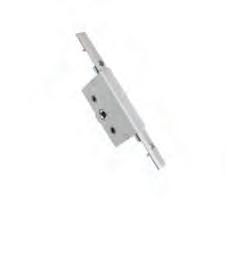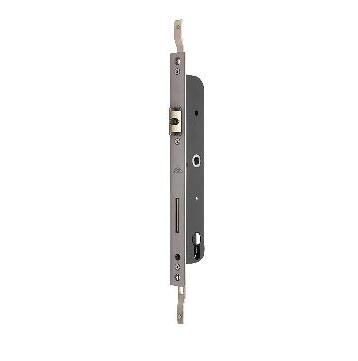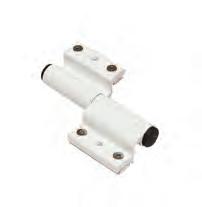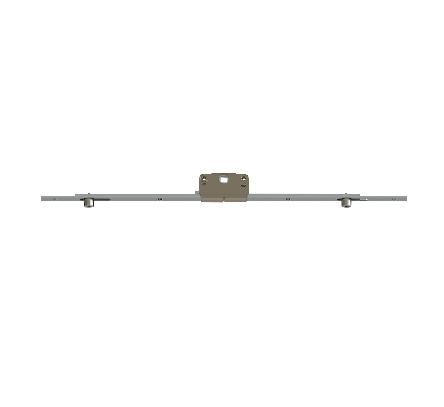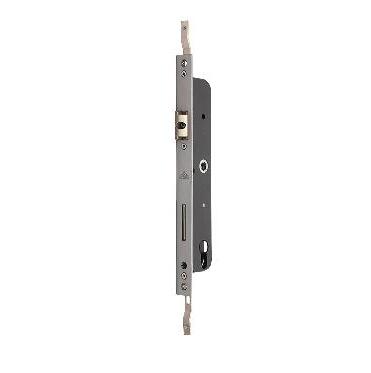



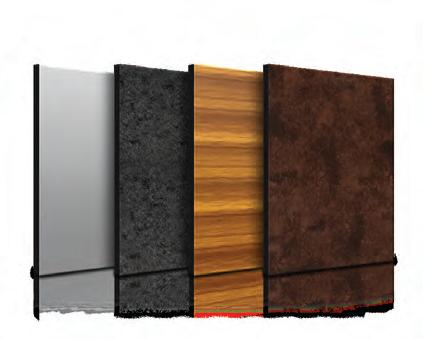



































Easy and quick fixing









































Easy and quick fixing
Setting the tone for design and modernity in the world of aluminium windows. Supra7 combines modern design with the most refined finishes, for a uniform and trendy aesthetic for every room of the building. It is available in a great variety of mechanisms with the Asia, Kora, Prima and Aria aesthetic lines.

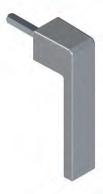



Universal application: compatible with 7 mm square pin.
Minimal and modern design
No base equals simple and elegant design.
Versatile
Available for side-hung, tilt-and-turn windows, as well as terrace doors and apex version for outward openings.
Vast range of finishes
Infinite finishes for infinite creativity. AntigermTM treatment also available.












Reliable & Durable
Variety & Eco Friendly
Application on almost any shape
Appreciated by architects & designers
Aluminum Windows and Facades





Established in year 1989, Powdertek offers wood finish powder coating process which is the latest technological breakthrough in metal coating giving the strength and durability of metal and the aesthetics of wood.



can cater upto 20 feet long objects like aluminium sections/profiles and also rectangular/flat objects like steel door and frame upto 16’x4’
POWDERTEK
Registered office and Unit - I
A-18/A, Naraina Industrial Area, Phase-1, New Delhi-110028. India 011-41411141,47050181-83
Unit - 2
Sampla- Beri Road, Kultana Ismaila Street, District Rohtak, Haryana - 124501, India
011-41411141,47050181-83
+91-9811173861, +91 7770888666, info@powdertek.in www.powdertek.in


As a leading manufacturer & trader of Aluminium Extuded Profiles in India we at S. R. Extrusions try to delight our customer by giving the best quality satisfaction and product designs.
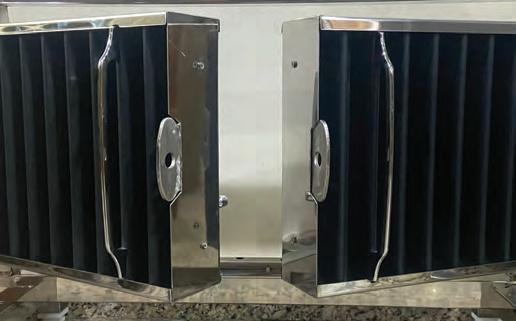



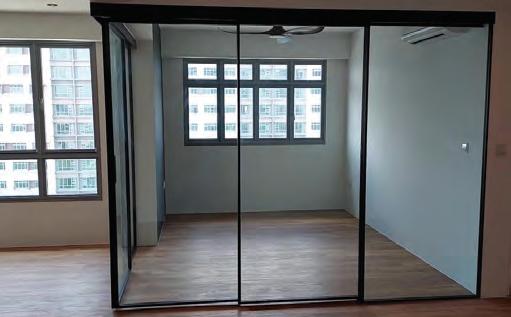
l ALUMINIUM GATE PROFILES l WOODEN FINISHED ALUMINIUM FACADE
l ALUMINIUM RAILING l SYSTEM WINDOWS- EURO SERIES
l SLIM SYNCHRO SLIDERS (SOFT CLOSE)
Our claim to success is hallmarked by offered quality products that gained us huge recognition!
Volume 7 | Issue 6
November-December 2021
PUBLISHED BY F & F Media and Publications
C-55, Okhla Industrial Area, Phase - 1, New Delhi-110 020
T: +91-11-40623356
FOUNDERS
Amit Malhotra TECHNICAL PANEL
Mahesh Arumugam Director
Meinhardt Façade Consultants
KR Suresh
Regional Director Axis Façade Consulting
EDITORIAL
Renu Rajaram renu@wfmmedia.com +91 9312864830
Shefali Bisht editorial@wfmmedia.com
DESIGN & CONCEPT BY Sanjay Bandre
MARKETING & OPERATIONS
Kapil Girotra kapil@wfmmedia.com +91 9560925255
SUBSCRIPTION & CIRCULATION Devagya Behl support@wfmmedia.com +91 9871151112
Mukesh Kumar mukesh@wfmmedia.com +91 9560088995
RNI: DELENG/2014/57870



12 The Market for Fenestration Industry in 2020-21
Farid Khan, Director and CEO, profine India Window Technology Pvt. Ltd.
18 “The Indian Façade & Fenestration Market to Reach Around US$180 Million by 2025”
Manish Bansal, CEO & Director, Window Magic
22 Market Dynamics of Fenestration & Architectural Glasss in FY 21
Shailesh Ranjan, Head – Business Planning, operations & Technical, Asahi India Glass Ltd (AIS)
29 Smart Glass for Better Health & Wellness
Krishna Prasad, Managing Director - India, View Inc
32 The Market for Architectural Glass in 2020-2021
Nitin Mehta, Co-Founder and Executive Director, ALCOI
37 “Today Homebuyers Show Confidence in Real Estate Investment”
Abhinav Kanchan, Senior Vice-President, SOBHA Ltd
40 Real-Estate Landscape: The Year That Is & The Year That Will Be
Bijay Agarwal, Managing Director, Salarpuria Sattva Group
46 Performance of Real-Estate Business in 2020-’21 & Future of the Industry
Sanya Aeren, Chief Advisor, Marketing & Communications, Berkshire Hathaway HomeServices Orenda India
50 “The Market is Expected to Reach Pre-Covid Levels by the End of 2021”
Irfan Wasil, Zonal Manager - Karnataka Region, Kin Long Hardware (India) Pvt Ltd
56 “Industr y Size to Grow More Than 30% Year on Year”
Amit Malhotra, Leader, McCoy Group of Companies
58 Past and Current Economy Scenario – Hardware Sector
Vikas Malhotra, Director, DNV Global Pvt. Ltd
80 Industr y Speaks
Interview with Mr. Sanjay Meela, Director, Sudhakar Profile Systems
88 Façade Sustainability: Emphasis on LEED Requirement
Ar. K. Saraswathi, Principal Architect and Partner, Conserve Consultants
91 Choosing the Right Façade and Fenestration Products
Ar. Behzad Kharas, Chairman & Managing Director, The BNK Group
98 Face to Face
Interview with Ar. Dikshu C. Kukreja, Managing Principal, CP Kukreja Architects
Cover Image, Courtesy: CP Kukreja Architects (CPKA); Project: The India Pavilion at the Dubai Expo 2020
DISCLAIMER: With regret we wish to say that publishers cannot be held responsible or liable for error or omission contained in this publication. The opinions and views contained in this publication are not necessarily those of the publishers. Readers are advised to seek expert advice before acting on any information contained in this publication which are very generic in nature. The Magazine does not accept responsibility for the accuracy of claims made by advertisers. The ownership of trademarks is acknowledged. No part of this publication or any part of the contents thereof may be reproduced in any form or context without the permission of publishers in writing.
WRITE TO THE EDITOR Please address your suggestions to: The Editor, Window & Façade Magazine, C55, Okhla Industrial Area, Phase – 1, New Delhi, 110020 or email renu@wfmmedia.com. Please provide your full name and address, stating clearly if you do not wish us to print them. Alternatively log on to www. wfmmedia.com and air your views. The opinions expressed in this section are of particular individuals and are in no way a reflection of the publisher’s views.
“Printed and Published by Amit Malhotra on behalf of M/s F & F Media and Publications Printed and published at Print Plus Pvt Ltd, 212, Swastik Chambers ST Road, Chembur, Mumbai 400071. Name of the Editor-Ms. Renu Rajaram”

We have seen builders’ stocks dwindling in the recent past with projects getting stalled or delayed due to the pandemic. Their hopes have been given a fillip with the improved situation and the real-estate market, and the construction industry in the second half of 2021 as a we are seeing light at the end of the tunnel.
The prospects for the façade and fenestration industry in the immediate term remain relatively good, although a volatile economy casts some uncertainty over short term prospects. This edition’s cover story, since it is the year end edition, is on the performance of the façade and fenestration industry, and the ancilliary industries including windows, doors, cladding, glass, architectural hardware, etc. Based on the comments from many industry leaders and reports by various agencies analysing business trends, we can come to an inference that the Indian window, door and façade market will vroom again, if the manufacturers stress upon maintaining quality, testing, certification while advancing technologies including digitalisation and sticking on to sustainability priorities.
This edition features many articleds from leaders and experts analysing the performance of various industries including real-estate, door and window, glass, architectural hardware, profiles cladding and many other products which are segments of façade and fenestration industry. Many authors give their views on future performsnce of these industries too, looking at the market demand. We tried to make this edition an interesting read with the features – Face to Face – with the renowned architect Dikshu Kukreja (Managing Principal, CP Kukreja Architects), who designed the India Pavilion at the Dubai 2020 Expo which is a celebrated project projecting India’s culture, progress over the years, business opportunities, above all the unity of people and different cultures of our country at the expo.
In the section Industry speaks, WFM has featured an interview with Mr.Sanjay Meela is the Director of Sudhakar Profile Systems, a 3rd generation entrepreneur from a family which has a legacy of 50+ years in PVC industry. Apart from these, there are many articles on brands and products in the market, on their latest initiatives or launches.
Our magazine, Window and Façade, aims to keep our readers up-to-date with the latest in the industry, our website too helps to keep you informed. You can now receive your industry news updates from www.wfmmedia.com. Please step inside our website to find out more.
Looking forward to your comments and feedback on this edition.
Renu Rajaram renu@wfmmedia.com

The growth of the fenestration industry is directly associated with the growth of the ongoing real estate market. In recent times, the real estate industry has drastically been affected by the uncertain economic environment created by the pandemic. 1st wave of the pandemic completely shut down not just industries but the whole economy as there was a question of human survival. Things started to improve in the 2nd half of 2020 which remained for a few months and provided some momentum for the real
estate industry. But unfortunately in the 1st quarter of 2021, the 2nd wave arrived and disrupted the economic momentum. This time the lockdown was partial with less impact on the economy as the industries were better prepared with COVID SOPs and a large vaccination drive. Despite the significant disruption in 2020 and early 2021, the demand for residential space remained intact. Low-interest rates of housing loans, concessions on stamp duties, etc., by certain state governments also added support in recovering from the slowdown in the 2nd half of 2021
Now when the vaccination drive is in full swing and covid cases are declining, we can see the positive sentiments are high for the economy. Real estate has started doing well throughout the country, as a result, demand for construction material including fenestration, i.e. windows and doors have again increased. The material window and door market in India are estimated to be INR 15,000 crore and based on the future projections, it will keep rising due to rapid urbanisation and development of commercial buildings. Other growth drivers for the growth of the fenestration
industry are increased purchasing power of the middle class, increased awareness for advanced, energy-efficient and sustainable window and door systems, etc. The window and door market in India comprises aluminium, wood, steel and uPVC, where the share of wooden windows will keep decreasing due to environmental concerns, i.e. deforestation. Therefore, the growth of other materials make windows and doors is natural and evident.
Being one of the Global leading window and door profile manufacturers, we can say the future belongs to the system windows and doors which besides offering ease and comfort, add value to customer’s lifestyle and contribute to the environment. uPVC and aluminium being the materials in-demand and also the most well-known materials for making advanced window and door systems which offers many advantages missing in the traditional material make windows and doors. Let’s take a look at the benefits and contributions of both the material make windows and doors on human life and the environment.
The invention of PVC or Polyvinyl Chloride in the 19th century introduced dramatic changes in the face of the manufacturing and construction industry. Today, an ‘unplasticised’ form of PVC, also known as uPVC, is used to build high-quality, durable windows and doors that offer tough competition to traditional materials like wood. Whether it is the design, functionality, or durability, each uPVC window and door possesses a unique set of characteristics to fit the needs and match the decor of your building. You can choose from a variety of styles and range of window and door systems like
casement window and door, sliding window and door, sliding and fix window, tilt and turn window, top hung window, sliding and folding door, lift and slide door, casement window with mesh and grill, etc.
The simple reason behind the popularity of uPVC windows and doors is their multiple qualities that bring immense value to homes and benefit homeowners in myriad ways.
Good quality uPVC windows and doors are tough and durable. They don’t absorb moisture and don’t rot, warp or corrode, which makes them suitable for even the harshest of weather conditions. Due to their capacity to withstand extreme temperature changes, they continue working and looking fine for several years. As they tend to last long, they simply add to the value of residential and commercial properties. Unlike wood windows and doors, they don’t need to be painted or varnished. Cleaning them is also easy, as you simply have to wipe them with soapy water.
Energy efficiency is the need of the hour, as it is good for the environment as well as living beings. Amongst the several ways that help increase the energy efficiency of properties, the installation of uPVC windows and doors is one. The low conductivity of this material and tight seals and double or triple glazing of the uPVC windows make homes energy-efficient. They significantly reduce the loss of heat during winters and prevent solar heat gain from outside during summers. As a result, you can end up saving energy costs by not using electric devices on heating or cooling your house for hours.
The uPVC windows are fabricated with specific noise-resistant properties that can reduce noise for up to 30-40 dB. Their doubleseal system enables acoustic control requirements within your house for keeping the noise at bay. These steps help inhabitants to maintain their stress levels
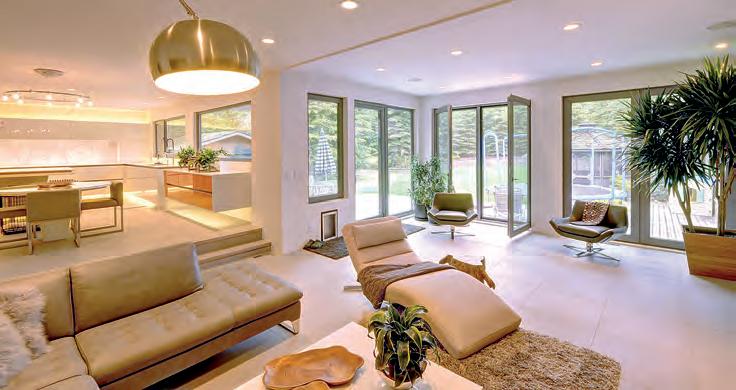
while unwinding after a tiring day without any disturbance. These sound-proof windows are also helpful at the time of storms, torrential rains and high winds, as they help in reducing the noise level while preventing water and dust to enter the home.
The extrusion process of uPVC window and door profiles is relatively energy-efficient, compared with other materials. Another benefit: uPVC is an alternative to wood, the rate of cutting of forests has slowed down. uPVC profiles are environmentally friendly as they can be fully recycled and reused for the production of uPVC profiles again. Good brands have been using Calcium-zinc instead of lead for producing window and door profiles which make them 100% lead-free and sustainable products. Calcium-zinc is a stabilizer that makes uPVC profiles even more resistant to the most aggressive weather conditions.
Aluminium has been a widely used material for manufacturing windows and doors not just in India but across the globe. It is
one of the most common and one of the most abundant available metals on this planet. The qualities of this metal make it perfect for manufacturing modern window and door systems. Let’s look at the qualities:
1) Robust and Lightweight: Aluminium is not just one of the strongest but also the lightest metal in comparison to Steel or Copper. As a matter of fact, aluminium has a far better strength to weight ratio than
steel when used as an alloy. Aluminium alloy properties are such which remain intact in extreme weather conditions whereas Steel becomes brittle in cold environments. Therefore we can say aluminium performs and cope extremely well with extreme weather conditions.
2) Corrosion Free: Aluminium is extremely resistant to corrosion from anything the weather can throw at it, including acid rain, and won’t be damaged by cleaning products. And unlike timber, aluminium window frames won’t swell, crack, split or warp over the years whatever the weather. Protection from corrosion can be increased even further by anodising or powder coating the surface.
3) Highly Durable and Easy to Maintain: Aluminium has been known to be extremely durable and able to withstand natural forces. These include UV rays, rust, rot, fire and even bending. Consequently, it is rather maintenance-free and only requires periodical cleaning. In short, it is extremely well-








suited for places that experience extreme weather.
4) 100% Recyclable: By installing aluminium windows and doors, you contribute towards environmental sustainability. This is because it has minimal impact on the environment. Since these windows last for many years, you don’t have to switch or replace them anytime soon. Furthermore, aluminium frames are easy to recycle and reuse, making them an eco-friendly material that’s important to use in today’s times, where global warming is a huge concern.
5) Excellent Surface Finish:
Aluminium window and door profiles are available in multiple colour options by anodizing or powder coating. It gives the profile surface a smooth or texture finish. Anodizing or powder coating not only give windows and doors decorative and appealing looks but also provide an extra layer of protection against corrosion. Aluminium doors and windows have always been the first choice for commercial projects for many years now. But for the last few years, residential spaces are also increasingly gravitating towards the aluminium window and door system. The reason is simple they are stylish, customizable, advanced with many operational features, easy to operate and durable. There
is a variety of range and style available to choose from based on the architecture of any building be it home, office or any commercial space in a combination of maximum height and width. The aluminium product range available are casement windows and doors, sliding windows and doors, fixed and slide windows, top hung windows, sliding and folding doors, etc.
We are quite optimistic about the future of the fenestration industry. The ongoing and expected future growth in the infrastructure sector, increase in FDI and growing middle class, lower interest rates give a clear indication that the modern window and door system market will get more opportunities and grow at a good rate. With India’s Metro and big cities becoming noisy and polluted, modern windows and doors are expected to become a priority for people thinking about constructing new homes or renovating their existing ones. Also, the sustainable part of these windows will be the deciding factor soon. With the growing number of façade and window consultants in the country, the industry will mature and give focus on quality rather than going for traditional and cheap quality material. At the same time, this segment needs more informative campaigns to create further awareness on quality windows and doors and their impact on human life.
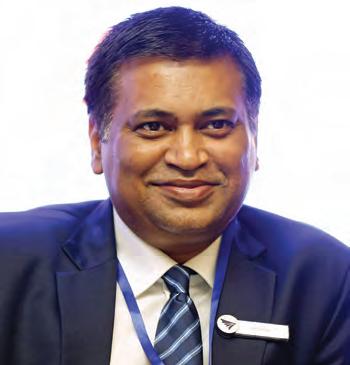
FARID KHAN Director and CEO,
Farid Khan has 24 years of experience in diverse industries serving in India and the Middle East. He had been associated for over a decade with leading public sector organisations in promoting MSME products in overseas markets. He is a guiding force to reckon with in the uPVC windows and doors industry in India. With brand “Koemmerling”, he has been instrumental in establishing the footprints of profine GmbH, one of the world’s leading manufacturers of uPVC profiles by forming the Indian subsidiary and setting up of local state of the extrusion facility in Vadodara, Gujarat. In 2017 the company ventured into the aluminium window and door systems and launched the brand “AluPure”, which has become a wellknown name in the fenestration industry. Under his leadership profine India with its brands, Koemmerling and AluPure is having further exponential expansion plans.


We see that the Indian uPVC doors and windows market was growing at an exceptional rate and was estimated to grow at a CAGR of more than 7% during the next 5 to 6 years.
Then came the COVID -19 pandemic, and due to lockdown trade restrictions were imposed. These restraints disrupted the supply chain and affected the windows and doors industry in 2020 like any other industry.
Technological development has changed the traditional outlook about the use of wood and aluminium doors and windows and customers are choosing uPVC more. Constant innovation is helping us to discover and deliver better. The technology used in making uPVC makes it very costeffective and easy to install, unlike others where installation is a hassle. The doors and windows made of uPVC are lighter but durable. uPVC has exceptional thermal performance, as during winters they resist heat loss whereas in
summers they oppose heat gain. This helped in making it popular in a country like India where we have a plethora of seasons. Apart from this, the quality used to make uPVC involves the use of reinforced steel which gives strength to it.
Spoilt by choice the customers are looking for more customised products and the manufacturers are pushed to the limits to introduce new designs and technology in uPVC doors and windows systems. There are different types of uPVC available in the market and customers can
select the designs which fit into their requirements and budget.
The strict COVID-19 rules imposed by the government affected the construction and housing industry and building projects got stalled for a very long time. These restrictions due to lockdown reduced the purchase of uPVC doors and windows. Though in comparison to other manufacturing industries, the uPVC industry has been optimistic post lockdown. The doors and windows industry didn't face an immediate impact as there was a backlog of orders which was needed to be cleared.
We do see that as people started spending more time at home, an increased number of customers started spending on renovation and construction of more comfortable living spaces. This trend may further drive the Indian door and windows market towards fast growth.
In the coming year, we do see that the trend of spending more time at home will stay and customers will also look for more energy-efficient and impactresistant housing infrastructure.

This boom in the demand will lead to innovation in designs and product material in the doors and windows system.
Supply-chain logistics have become a challenge after the COVID-19 restrictions in terms of cost and time. So more indigenous manufacturers are encashing on the opportunity. The inferior quality Chinese products are

no more creating havoc in the market, and customers are getting better quality products from more reliable manufacturers. Also, many international brands are venturing into the Indian market as currently, India is the world's sixth-largest economy by nominal GDP and the third-largest by purchasing power parity (PPP). All this is going to make international quality products available to the Indian customer at affordable prices, also since these brands are setting up local manufacturing units to keep the pricing competitive it will create employment opportunities as well.
Adding to this the Indian government initiative to provide affordable housing for all by 2022 and the development of smart cities across India will fuel the door and windows system. Currently, we have a shortage of 18 million homes; therefore, a massive level of residential homes construction is required to meet this demand of the housing sector. The residential

uPVC windows are the best choice for
sector thereby presents a huge potential for the expansion and adoption of UPVC doors and windows. And it will create a huge demand in the uPVC segment once the work starts in full flow.
Since uPVC is recyclable, offers UV protection, is saltwater resistant, and also provides insulation from rain - it is the best choice for the housing sector. The residential sector can give the uPVC doors and windows the required push to cut losses it faced during the last couple of years.
Stirring ahead amidst the fear of any new wave of COVID 19, uPVC doors and windows industry is finding a way to move ahead, as already the stalled housing construction activities are restarted and the demand for uPVC doors and windows are on increase. The return of the working-class population to urban cities post
covid and increase in disposable income will contribute to the further growth of this industry soon.
The future of the global door and window market looks promising with an expected growth of 8-10% by 2025. The main influence for the growth will be new constructions, renovations, and rising consumer demands for impact-resistant doors and windows, energy-saving products, and green products. The growth in the Indian market by the end of 2025 will reach around US$180 million. Market expansion is expected to be consistent in the long term due to the shortage of household units in the country. The integration of technology with elegance will create opportunities for the new manufacturers to enter the market hence, we will witness a massive expansion in this sector in the coming years.

MANISH BANSAL CEO & Director
Window Magic
Manish Bansal is the CEO & Director of Window Magic, a leading uPVC brand in India. He did his graduation from the University of Kent, Canterbury, United Kingdom. Bansal is a successful business leader prospering in the building and construction equipment industry. He played a significant role in transforming Window Magic into a profitable venture. His clear vision, commitment to quality standards, market & consumer foresightedness added new insights to Window magic as a company. Bansal carries distinct expertise in global strategic management, including development, expansion, and turnaround initiatives. His belief and understanding of future market trends have helped in popularising uPVC products in India. Bansal has successfully established a reputation of being a dynamic, visionary, and strategic leader of the industry.
















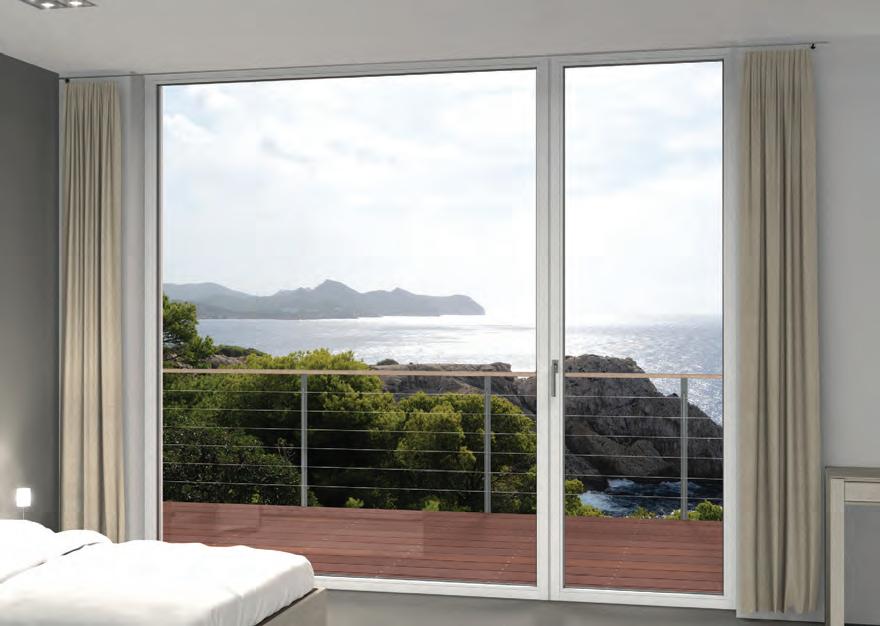













Glass & fenestration industry has seen significant growth in the last two decades especially in terms of usage of high-performance glasses due to an increase in awareness. Government initiative towards sustainability has also resulted in increased demand for highperformance glass products. Highperformance glasses are those glasses that have the functional ability to reduce heat ingress and at the same time, they allow optimum lighting inside the building, resulting in the reduction
of energy usage in a building by reducing cooling and lighting load. Following are the key driving factors for the glass industry:
• Per capita glass consumption in India is just 1.9 Kg as compared to the global average of 7 Kg per person per year. It indicates that the industry is ripe for growth and it will fuel the growth in Tier II & Tier III cities in the next ten years.
• The Green building movement in India started in 2001 and since then it has picked up pace significantly. The government has also promoted the
movement by announcing that India is planning to achieve Netzero status by 2050.
• The use of value-added products is a clear indicator that there is a significant increase in awareness amongst the consumers and key stakeholders.
• Apart from sustainability, the Government initiatives like Make in India, the launch of the Energy Conservation Building Code (ECBC 2017), National Building Code (NBC 2016), all of which promote the usage of the right building materials including glass.
• Urbanisation is also an important factor that will increase the usage of glass and boost the growth of the industry.
The above factors have helped the industry to grow, but the journey of the glass industry till now was only an upward movement, however, a lot of roadblocks have put the brakes on the growth of the industry as well. However, the industry has grown at the pace of around 7-9% CAGR in the last 1520 years till March 2020 when the pandemic put a complete break on the growth path.
Even overall fenestration industry has seen a radical change during a pandemic. The fenestration industry is experiencing a need for consolidation and more and more organized players are expected to emerge from too many small players. It is good for the industry as it will bring stability, quality and professionalism to the industry. The Windows market which is estimated at around INR 17,000 Cr is also highly fragmented. However, it is also expected to take a similar path as the fenestration industry is taking. As per industry research report, the global glass industry is expected to grow at around 4.1% over the next 5-6 years and the Indian fenestration industry including glass is expected to grow at a much faster rate as compared to the global average.
The glass industry has its inherent challenge because glass manufacturing is a continuous process. Once the furnace is lit, it can’t be stopped till the next 12-15 years. This was the biggest challenge during the COVID period where demand almost became standstill but all 11 furnaces in India were producing huge amounts of glass on daily basis. This quantum of glass was impossible to even

stock, hence if the produced glass sheets were broken (collected) and the broken cullets were put back along with the other raw materials into the furnace.
A lot of external factors also
impacted the demand during the COVID period. Real estate contributed nearly 7% to India’s GDP in 2020. As per the projected growth trends during the pre-COVID-19 era, the sector’s contribution was likely to rise to 13% of India’s GDP by 2025 but the current coronavirus lockdown has surely put brakes on its growth momentum. As per revised estimates, it is expected to be at 10% of India’s GDP by 2030. In the commercial sector, net absorption in the top 7 cities was recorded at 40 Mn sqft in 2019, growing by 19% over 2018. Net absorption decreased by 33%, QoQ with 5.53 million square feet space leased during January-March 2021.
In addition to that, labour issues and supply chain challenges also put a brake on the glass industry where labourers returned to their hometown from the construction sites and even after the situation became conducive for construction, work couldn’t start at the normal pace because of unavailability of manpower.
However, a lot of effort was taken and the threat shown by the pandemic was arrested at a much
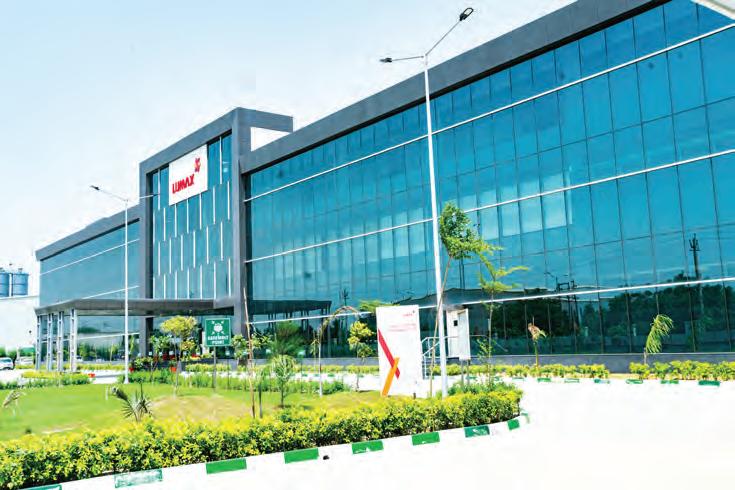

faster rate to bring the economy back to normalcy. Glass industry showed a ‘swoosh’ recovery because of the factors given below:
New office space completions in the first quarter of 2021 stood at 13.43 million sq. ft., up 5% over the fourth quarter of 2020. According to the CBRE, flexible office space in India stood at 36 million sq. ft. in 2020 and is expected to grow at ~10-15% over the next three years (until 2023).
The residential sector has shown a positive growth on account of govt subsidy, increase in online buying and increase in demand for mid-sized residential projects. As per CBRE report, buying sentiment is expected to remain strong and help support

demand for upcoming new launches though underlying risks still remain. Affordable Housing has taken a back seat. Homes in the range of INR 90 lacs to 1.5 cr are preferred. This will push better specifications in the housing segment. Property buying process going online - 60% as compared to 39% earlier.
Government investment towards social infra project (INR 3.65 Lakhs cr by FY 25) & airport (INR 1.43 Lakhs cr by FY 25) has fuelled demand in the glass industry for the next 5-6 years. It will help in bringing the industry back to a rapid growth path.
The global economic scenario also helped the Indian glass
industry to recover at a much faster pace. Increase in shipping cost, putting Anti-dumping duty on few countries for glass imports into India and Chinese economic turmoil along with the shutting down of many glass plants in China resulted in a boost to Indian Glass Companies and it helped in the price correction as well which was under pressure since long because of the huge imports.
MARKET DYNAMICS OF ARCHITECTURAL GLASS IN FY 21 FY 21 can be seen in three phases which is the first three months, the second three months and the last six months. The first three months was a complete

in the tune of around 30% as compared to FY 20.
During the lockdown period, companies focussed on the overall consolidation and business process improvement. It helped them to be ready for the upcoming demand and changes in the overall business dynamics. Life was not the same for the glass industry post-pandemic. A lot of radical changes were seen and a few of them were as follows:
1. Digitization of the business process: Customers were more
washout as there was no movement because of complete lockdown. This was the phase where the industry lost heavily because of huge inventory and zero demand. The second three months was the phase where a very small residual demand was fulfilled but there were no new projects closed or a new discussion started. This was the phase where losses were still high, but companies were trying to bring the inventory down. Phase three was the second half of FY 21 where demand picked up at a much faster rate as compared to what was expected. But overall industry saw a huge decline in growth which was

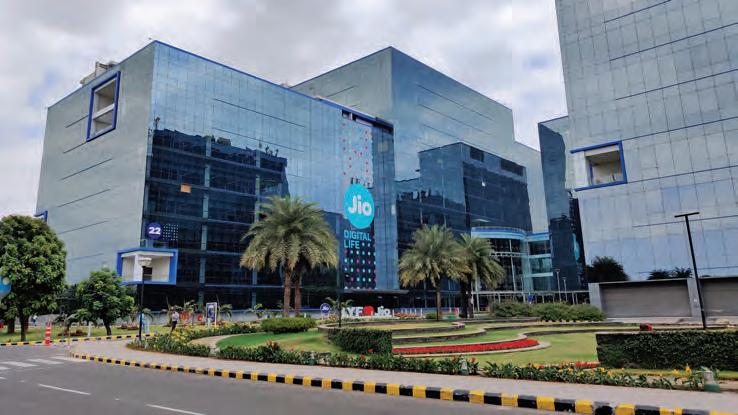
forthcoming in the digital way of engagement and also most of the business discussion happened online.
2. Increase in value-added products’ demand: Green building movement, implementation of govt codes on glass usage has increased the demand of valueadded products.
3. Consolidation of the industry: Industry has seen a consolidation where few major players downstream of the industry were able to sail through the impact of the pandemic and many small players are struggling to survive.



4. Resetting the industry norms:
The economy is on the recovery phase, office spaces are making a shift in preferences by recalibrating the way office was built and the residential sector is at a revival phase
The glass industry has shown great resilience and has come back to the growth path by recovering rapidly from the setback created by Pandemic. Growth in the residential, commercial and Govt sector, correction in price after a long time, positive Government initiatives, net-zero campaign, industrial consolidation and technological revolution in the industry is taking it to new heights. However, an increase in the input cost may put pressure on the overall margin and in case it doesn’t convert in recover the cost in the form of price correction.
The pandemic forced us to find new ways to work and collaborate to be productive and efficient and we have to make sure we don’t lose sight of these. The market has begun to re-emerge and demand has started growing again and recovery has been good. The construction business continues to expand as the government sets ambitious targets for physical infrastructure investments to boost economic growth. Between 2019- 2024, it is targeting a spend of US$455 billion in infrastructure development and the Construction industry is expected to record a CAGR of 15.7% to reach $ 738.5 billion by 2022. The construction and building industry accounts for 60% of the total glass consumption by value, hence the outlook for companies like AIS is bright.

–
Shailesh Ranjan, Head –Business Planning, operations & Technical, Asahi India Glass Ltd (AIS) has over 15 years of rich experience in the glass industry for handling different profiles like business intelligence, product management, project management, marketing, strategy, technical marketing, business planning & operations. He has participated in various exhibitions and seminars as a keynote speaker delivering lectures on different dynamics of glass. Shailesh is a certified green building trainer and his key areas of expertise are in promoting energy efficiency, net-zero, safety through the usage of glass in the Architectural segment for different climatology and type of buildings.


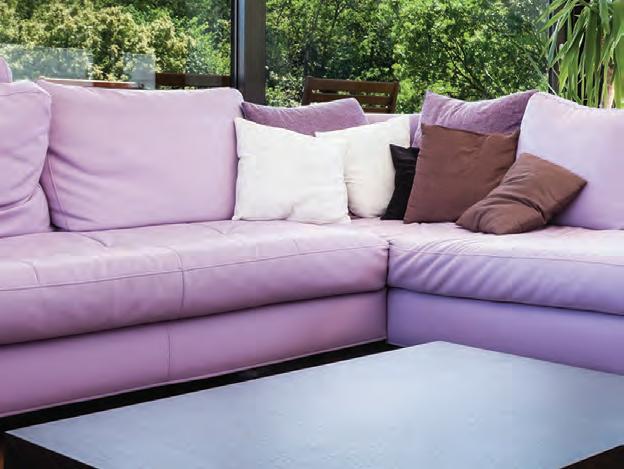









Companies spend significant amounts of money while building their campuses to provide multiple amenities to their employees to create a positive work environment. These amenities can range from cafes and restaurants dishing out international cuisine, soaring lobbies, state-of-the-art gyms, childcare centres, yoga classes, free mental health counselling sessions, and more.
While each of these amenities is useful, the question is: How many employees use these amenities? Nearly all require an employee


With the elimination of blinds and shades, smart windows can help eliminate one other germ-carrying surface at face level
to specifically ‘opt-in’ to use them. This is one of the reasons employers realise a lower return on investment from these amenities.
On the other hand, what would it cost employers to move into buildings or build campuses that maximise daylight inside offices—without the glare and uncomfortable temperatures— that naturally improves their employees’ health and wellness? It’s priceless!
According to research published in the Harvard Business Review, natural daylight is the #1 amenity that employees desire to have in their workplaces. Multiple scientific studies prove that employees working in offices with Smart Windows experience 51% lesser eyestrain, 63% fewer headaches and are 77% less likely to report being depressed. Also, they experience an additional 37 minutes of deep sleep and demonstrate 42% higher cognitive function. This equates to a 21% increase in productivity, boosting their bottom line and allowing
them to justify an investment in smart windows with payback periods ranging from a few months to a couple of years.
As part of a post-COVID-19 return to office plan, employers are developing new standard operating procedures to provide a safe and healthy work environment for their employees. With smart windows installed as a digital façade on buildings, an additional 8%-10% of perimeter space is available for employers to provide more social distancing between employees or plan for a larger work area per employee. Further, with the elimination of blinds and shades, smart windows can help eliminate one other germ-carrying surface at face level, reducing the risk of infection and loss of work due to employee sick days.
When it comes to workplace amenities, it is tempting to choose something fun and flashy, but the most beneficial amenity a company can provide is one that everyone can enjoy while improving their health and productivity..

KRISHNA PRASAD Managing Director - India, View Inc
Krishna Prasad leads the business for View Inc in India. View Inc is a smart building platform company and the market leader in dynamic windows. View windows use artificial intelligence to automatically adjust in response to the sun and increase access to natural light, acting as a digital skin for smart buildings that improve occupant health and reduce energy consumption to mitigate the effects of climate change. Prior to leading View Inc, Krishna Prasad was the Vice PresidentSales with Quantela Inc in North America. Krishna Prasad has 20+ years of experience.









Construction is a vital sector in architecture. Many sites have opened while observing strict safety protocols, and this has kept consultants and contractors busy despite the challenging months. Nevertheless, crises and opportunities seem to have had a massive impact on the façade and fenestration sector compared to real estate. Due to the effects of COVID-19, the façade and fenestration industry faced challenges like shortages of liquidity, materials, labour, etc. As a result, many upcoming projects were halted due to the recession. The cost of products,
materials & labour has also increased dramatically. Although the demand for façade materials may have decreased due to cost constraints, things seem to be finally getting back on track.
Glass has transformed modern architecture, allowing people to enjoy panoramic views. Flat glass is widely used in industrial settings for numerous end-products, including buildings and windows, solar cells, and windscreens. The automotive industry, building and construction sector are significant users of the same too. Flat glass plays a vital role in mitigating the effects of climate change by promoting energy conservation and lowering greenhouse gas
emissions. In addition, this glass offers multiple end-user applications in healthcare, optical, aerospace, electronics, and telecommunications. Unfortunately, the start of 2021 saw a rise in glass costs compared to the previous year, causing a big hit on downstream enterprises, like glass processors, façade contractors and real estate developers.
Aesthetics matter in high-end construction and the new-age user is primarily drawn to appearances that strongly favour the flat glass market. Furthermore, due to beneficial characteristics like clarity and transparency, glasses are in high demand. Produced in small and large-scale units, this


glass undergoes a rigorous making process, and the need for the same continues to rise, thanks to advances in the chemical industry. With technological advancements, the glass for the manufacturing process has become smoother and faster, resulting in higher production volumes.
The negative impact of the COVID-19 pandemic has also created a demand spike for fenestrations due to delays in completing existing projects. Alongside, the changing face of this industry now reflects a more experimental generation of endusers who seek revolutionary, nontraditional materials, new colours and designs. Energy-efficient elements top the list of must-haves in their homes and offices. For this generation, doors and windows are not just about enhancing the aesthetics of the interiors and exteriors but keeping out the unwanted.
Cities in India are expanding vertically and this results in formation of heat islands where products that are not good for the environment
exacerbate. By making the switch to eco-friendly fenestrations one can ensure the overall wellbeing and productivity of the occupants. While in the long run creating iconic structures to evoke a modern aesthetic ethos remains the primary focus, this also brings with it the growing threat and real danger of ignoring the environmental prerogatives of sustainable architecture and development.
The orientation of a building is critical for determining its exposure to sunlight. Therefore, solar exposure on a façade is continually changing. Hence, to control solar heat gain, we need to develop façade systems that complement the climatic functioning and quickly adapt to the building orientation. Controlling solar heating through fenestration brings with it a plethora of other benefits for the environment too.
Material selection is pivotal
for designing sustainable façades. Improving the thermal performance of building envelopes and minimising thermal bridging are critical design strategies for sustainable façades. Thermal bridging within a wall occurs where a highly conductive material, such as metal support, penetrates the façade as an insulation layer that can be incorporated into all types of façades.
Heat transfer through façades follows the fundamental principle of flowing from higher to lower temperatures through conduction, convection, radiation and air leakage. Therefore, understanding these factors can help to choose a suitable material for the fenestration.
Thermal comfort is the condition that defines a person's state of mind in terms of whether they feel too hot or too cold in a particular environment. Therefore, it is critical to choose façades systems based on their thermal performance. According to research, the Architectural Glass market was valued at USD 71010 million in 2020. It is estimated to reach USD 114030 million by 2027, at a CAGR of 7.0% during the forecast period 2021-2027. As per Mordor Intelligence, the flat glass market in India was valued at over USD 2 billion in 2020 and projected to register a CAGR of more than 4% during the forecast period (2021-2026). Though COVID-19 has impacted the market, projections reveal the Indian real estate industry market size to reach USD 1 trillion in 2030 from USD 120 billion in 2017, the demand for glass is expected to rise.
Post the pandemic; the


building industry has adopted safety protocols to reduce human interaction and minimise transmission risk during manufacturing, transportation, and installation. On the other hand, demand for automation in this sector is also on the rise. With minimal disruption, design practices have succeeded in shifting face-to-face communication to videoconferencing.
The pandemic has acted as a catalyst to implement this already available technology and helped reveal its potential to reduce transport, associated costs, time, energy, and emissions. It has also enhanced collaboration across geographies. However, design practices need to re-evaluate their offering and work more efficiently systematically. We need to step up qualitatively to add more value to our clients. It is time to be creative and innovative, and automation through parametric software will play an important role in increasing efficiency.
Rapid industrialisation
combined with the adoption of intelligent and energy-efficient technology positively influences the flat glass demand. More than 45-50% of India's flat glass industry is linked to the architectural sector. However, the energy sector's share is expected to increase, with India's emphasis on solar power and its

target by 2022. Alongside, one can use flat glass as a display for various electronic goods, like mobile phones and tablets.
Yes, the rapid construction of new housing and renovation/rebuilding activities has created more opportunities for the fenestration industry. Nevertheless, we have to undertake healthier environmental protocols to preserve the resources. In addition, by taking liquidity help from banks for sustaining and better utilisation, there is a need to adopt design automation and robotics installation, which could be a way to support this industry.
Automated robotics machinery accelerates the fabrication of façades. Earlier workforce utilisation was restricted to cutting, notching, slitting, cleating, punching, assembling, to glazing. Robotic stainless-steel welding makes the entire process seamless and more productive. Alongside, it reduces labour costs in the highdemand and high-quality Middle Eastern markets.
The Indian fenestration industry is directly linked to the construction






Rapid industrialisation combined with the adoption of intelligent and energyefficient technology positively influences the flat glass demand

Flat glass plays a vital role in mitigating the effects of climate change by promoting energy conservation
industry's performance, with an overall growth of 20% annually. Although the project business has slumped in recent years, retail is still on a steady growth path. But shortly, with massive project announcements from the Government and propositions by the Planning Commission to build over 20 million new houses
in the next ten years, the real estate sector in India continues to seek greener pastures. Thus, the related segments, including the windows & door market, will boom again, though the past few years saw a decline in sales. Therefore, it depends on us to architect a profitable and sustainable future for the industry.

Co-Founder and Executive Director, ALCOI
Nitin Mehta is the Co-Founder and Executive Director of ALCOI, one of India’s leading suppliers of eco-friendly high–performance fenestration solutions. With his futuristic outlook and innovative leadership, Nitin has led the growth of ALCOI into an industry leader in the realm of premium fenestrations. Under his leadership, ALCOI has completed 15 glorious years of its services and achievements and has transformed into a one-stop solutions provider for the design, manufacturing, installation and servicing of precision-engineered fenestration systems in India and abroad.
The new normal created a potential opportunity for not only the realestate sector but also for the prospective buyers contemplating buying their dream homes. Even though the last quarter of FY21 was marred by the second wave of the pandemic, the real-estate sector was quick to pull through and gracefully embraced this challenging situation. According to the Knight Frank report, the residential sales in Q3 of FY22 (July- September 2021) increased by 92 per cent across the top eight cities. Moreover, the new launches shot up to 90 per cent on a year-on-year basis. Emerging enquires about the properties and seamless adaption of technology, both by builders and customers, contributed towards the pacing up in the development of the sector.
The current year has turned out to be a boon for buyers as RBI has reduced the repo rate to 4 per cent
while making the reverse repo rate to 3.35%. Low-interest rates, taxes rebates, stamp duty cuts, extension of tax benefits till March 2022, and governmental scheme of affordable housing are some of the factors that have been encouraging home buyers to invest in the realestate sector. Cities like Chennai, Hyderabad, and Kolkata saw a marginal increase in their property prices but overall, the prices were either reduced or haven't increased significantly in both the second and third quarters of FY22, as per Knight Frank. Nevertheless, people are looking for more investment options during uncertain times like these. Also, there has been a surge in enquiries about 3BHKs and villas in Bangalore after the second wave as per a report by 99Acres.
With work from Home (WFH) continuing in most organisations and with the preference to rise in online education, people are in dire need of owing comfortable spaces coming with an option for open areas to relax and rejuvenate. The

sale of luxury properties, ranging from Rs. 50 lakhs to 1 crore, grew to 35% in Q3 attributing to buyers’ need for upgrading to a larger living along with state-of-theart amenities available at their disposal. Furthermore, the demand and availability of bigger homes in peripheral areas and Tier II and Tier III, with affordable prices, encouraged the buyers to shift to places closer to nature.
With the world taking a turn more toward the digital era, the process of purchasing real-estate assets have fallen in line too. The emergence and acceptance of PropTech, including Artificial intelligence, cloud-based technologies, virtual tours of properties, and Robotic Process Automation (RPA) created a convenient environment for developers to continue doing business even during the second wave of the pandemic. On the other hand, buyers found it suitable to book properties and do paperwork seamlessly on online platforms. Therefore, the procedure of researching and buying from anywhere in the world with few clicks proved to be one of the most significant advantages for the industry during the lockdown. The trend is likely to continue as it is taking the edge off travelling and searching for a home of preference. Today, people have progressive ideas about their homes, and their priorities are of global standards. Their demand helps builders to explore different

concepts in terms of theme, design, style, etc. The lockdown period was when people experimented with their taste with respect to home designs while giving ideas to builders for creating their dream homes. As a result, themed homes are one of the latest trends in the market that have gained immense traction recently.
Another trend that is notable during the pandemic is that young people want to make the right investment at the right age. Homebuyers, between the age group of 25 to 50, are also driving demand for second homes that could give them good returns. They are also looking for locations that are closer to social and medical facilities and are well connected with places providing basic amenities. Second homes are bought to make them either a vacation home or for earning rentals. The growth of secondhome purchases and real-estate investment has increased over the years, and this trend will continue to grow over the coming years as the expected ROI has now become the appealing component for buying a second home.


ABHINAV KANCHAN
Senior Vice-President, SOBHA Ltd
Developers are confident that the real-estate sector will continue to be one of the most significant contributors to the Indian economy as it is estimated that the sector will grow to USD 9.30 billion by 2040. The industry has already seen a rapid improvement in the last two quarters of the year. Increased sales, reduction in unsold inventories across states, and offers from developers for the festive season are further improving the sector's stability. According to a survey by No Broker, 82% of respondents have shown an interest in buying a property this year as compared to the 64% in the previous one. Also, considering the more controlled impact of the second wave on the real-estate sector than the initial wave, the third one is likely to be much shorter and less harsh.
The home buying market has been exposed to several changes. However, with the use of appropriate technology and foresight, the sector has stood the test of time. Some of the established real-estate brands have pivoted well to find their niche during the pandemic when the rules of the games have been reset.
Abhinav Kanchan is a Senior Vice President at SOBHA Ltd. He has 25 years of rich experience in strengthening brands and setting strong communications frameworks at FICCI, Aditya Birla Group, ArcelorMittal India & Moser Baer. He has a double Master’s degree (MA from St. Stephen's, Delhi University; & MSc in Media Management from the University of Stirling, the UK as a Chevening Scholar). In addition, he has specialised training in journalism, mass communications, content creation, integrated marketing communications, TQM and filmmaking from prestigious organisations in Tokyo and India. He is currently pursuing a Doctoral program. Value creation through credible and trustworthy communication practices is his forte. He volunteers his time for NGOs working with poor kids afflicted with cancer.
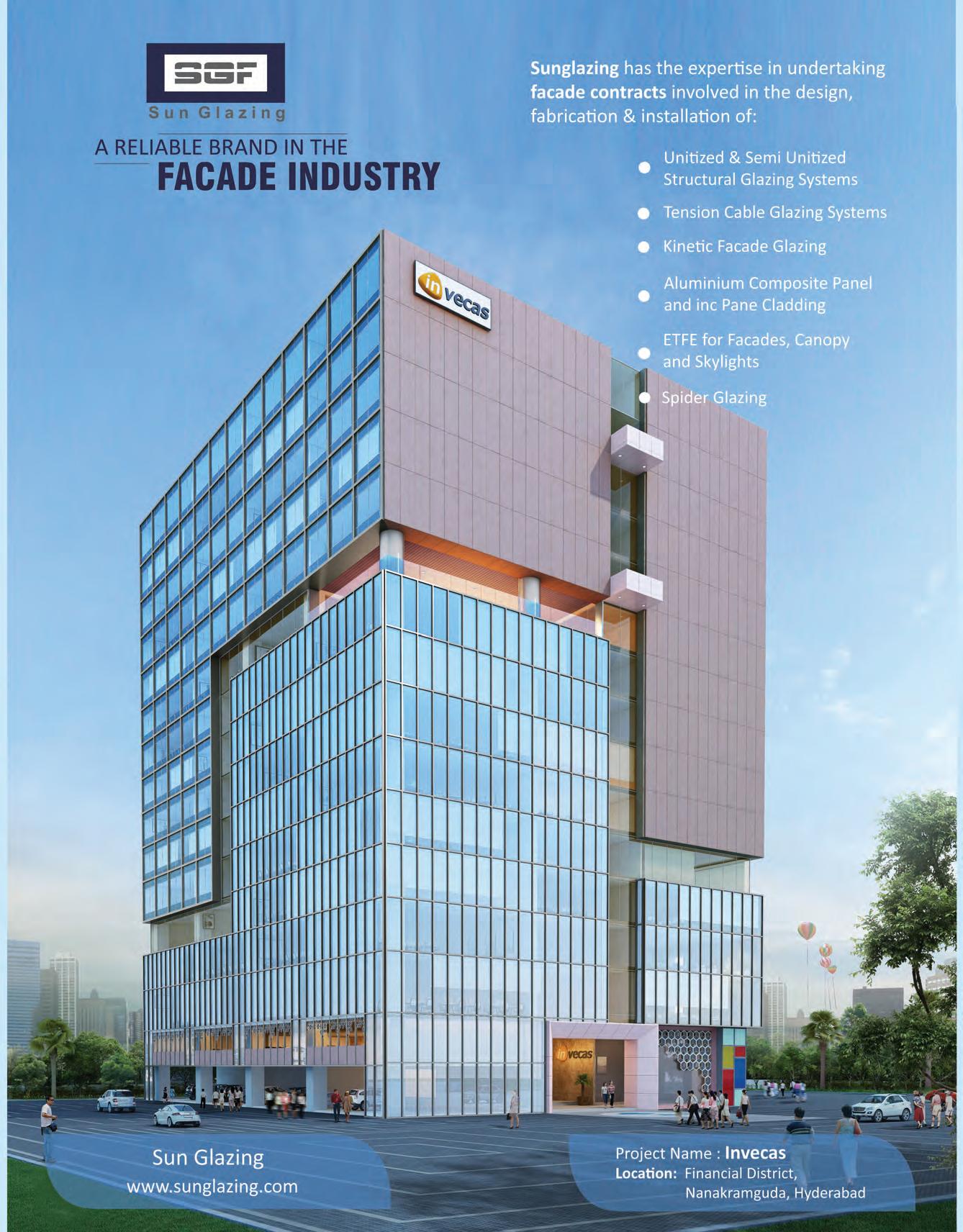

The year 2020 challenged the ‘normal’ for every business. 2021 is the year where phrases like the ‘new normal’ and adapting to ‘work from home’ became buzzwords. Imagination, innovation and digital transformation changed the way we live and work forever.
As we ushered 2021 with a pandemic-riddled economy, the real-estate industry was quick to
lay the groundwork for a quick turnaround, in the way it did business. As a result, the year proved to be better than expected with a new phase of growth, innovation, technology and investment trends.
There are many façades of the real-estate industry. Industrial realestate has been one of the topperforming sectors of commercial real-estate, for several years, based on demand and revenues.
The pandemic accelerated the demand on the industrial front, particularly for warehouses, data centres, and distribution centres. This trend opened new pathways for the sector to grow in the coming years.
Interestingly, the past 20 months have seen drastic changes in the lifestyle decisions of consumers. The demand for additional space in the house was a much-needed trend in the era of physical
distancing, work-from-home and home-schooling routines. The lockdown last year, made potential home buyers revisit the importance of owning a home and the demand witnessed by residential real-estate in 2020 has paved the way for the sector’s revival and rapid development. There was a spike in the demand for residential properties in tier 2, 3 cities as well. This upward indicator opened new doors of opportunities for tier 2, 3 cities to become the destinationnext of real-estate. Furthermore, this has created a chance for realestate players to explore and offer great home experiences to this untapped consumer demand.
The sales volume for the residential sector from the period October 2020 to December 2020 increased two times to 61,593 units, compared to 33,403 in the previous quarter, signifying healthy recovery, despite the challenges faced by the industry. According to an industry report, homebuyers took advantage of incentives offered by developers and low mortgage rates leading to a spike in residential sales in seven cities in the country. Sales in the fourth quarter of 2021 recovered to >90% volumes recorded in 2020 across the top seven cities.
Looking at the commercial real-estate market - Co-working spaces, at present, constitute a minute portion of the overall realestate business. In 2022, there will be greater demand for flexible leasing arrangements. Apart from companies such as logistics, fin-tech, and BPOs, only a few industries will continue operating remotely. Today, with companies considering office re-opening in a phased manner, they are looking at staggered timings for their employees. The rise of co-working
spaces is likely to raise property prices for projects around them.
The sector is also witnessing a digitisation wave on a large scale. With the changing paradigm, real-estate players were forced to switch gears to adapt to the new normal. From site visits online to online payment, developers are using innovative technological tools and practices across various stages of business operations. Virtual walkthroughs have been a gamechanger for the industry during the pandemic and will continue to be so, with players adding more layers to the entire marketing experience. Post-COVID era, technology has become an integral part of the realestate sector not only in sales and marketing but also in design and construction.
To sum up, table given below captures the leading real-estate highlights of 2020 – 2021
The real-estate sector’s contribution
• According to a industry report, real estate demand for data centres is expected to increase by 15-18 million sq. ft. by 2025
• The residential sector is expected to grow significantly, with the central government aiming to build 20 million affordable houses in urban areas across the country by 2022
• In July 2021, the Securities and Exchange Board of India lowered the minimum application value for Real Estate Investment Trusts from Rs. 50,000 to Rs. 10,000 - 15,000 to make the market more accessible to small and retail investors.
to the country’s GDP is set to go up to 10% by 2030, contributing about $1 trillion to the economy, according to an industry report. Let us look at some of the key trends which will shape the future of the real-estate industry. Here are 3 key elemental trends that we foresee in the coming years.
Data centres- Due to digitalisation in the aftermath of the Coronavirus epidemic, the demand for space to build data centres has increased. India’s transformation into a ‘digital economy’, has also helped this trend. As a result, data centres are emerging as an alternative real-estate asset class with enormous potential, and top realestate developers are entering the segment in order to reap profit from early investments. The demand for data centres in India has increased due to rising demand from fintech, pharmaceutical, e-commerce, media, education, manufacturing, retail, and hospitality. Policy
• The Government has allowed FDI of up to 100% for townships and settlements development projects
Under the ‘Housing for All’ scheme, 20 million houses are to be built by 2022, GST rate is brought down to 5%
• Under Union Budget 2021-22, tax deduction up to Rs. 1.5 lakh (US$ 2069.89) on interest on housing loan, and tax holiday for affordable housing projects have been extended until the end of fiscal 2021-22
• Driven by increasing transparency and returns, there's a surge in private investment in the sector
• Indian real estate attracted US$ 5 billion institutional investments in 2020, equivalent to 93% of transactions recorded in the previous year
Source - IBEF.
measures, growing customer base and increasing corporate data storage requirements are all driving India's data centre growth. Flexibility is the future of office space - The pandemic re-shaped the office working models for not only employees but also for employers. Leading companies moved their offices to co-working locations, and continue to do so
to optimise costs and achieve better employee engagement in current circumstances. Flexible working options have emerged as the workspaces of choice for all businesses and will only grow in the years to come. Companies are fragmenting their offices across ties 1 and tier 2 cities offering flexibility to employees. The coworking operators also will focus
on large enterprises for retailing their desks as these enterprises are also looking
The rise of last-mile delivery Warehousing – The pandemic accelerated the pace of the e-commerce industry to meet the consumers at home shopping needs. Swift fulfilment and timely distribution of orders became a must expectation of every online
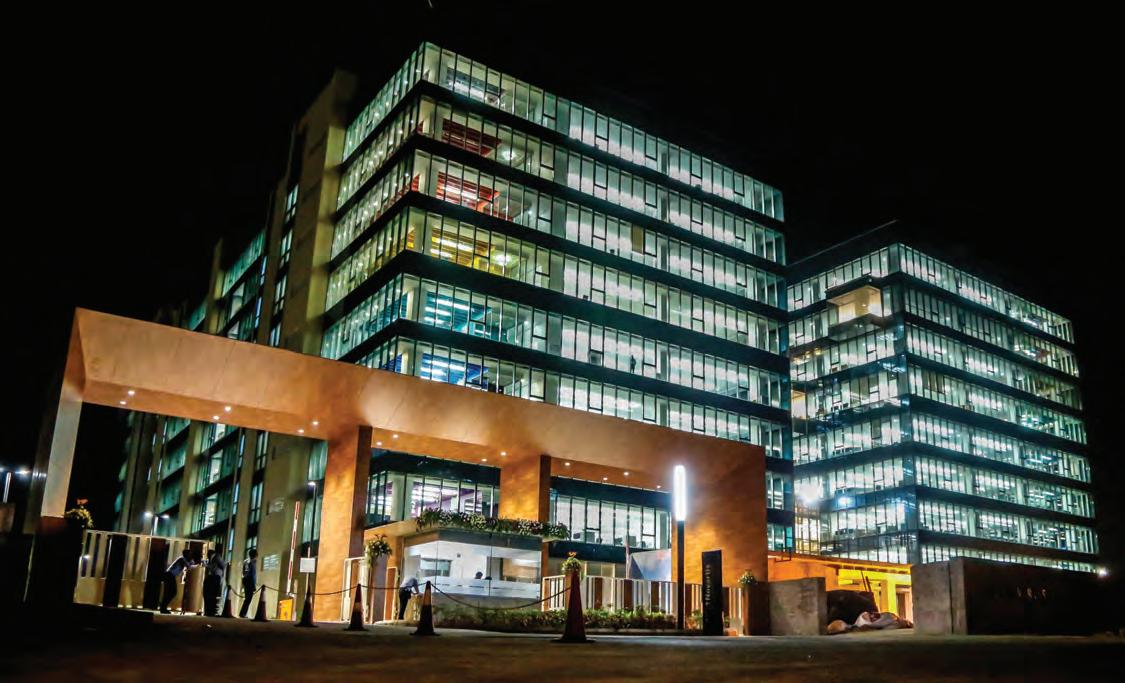

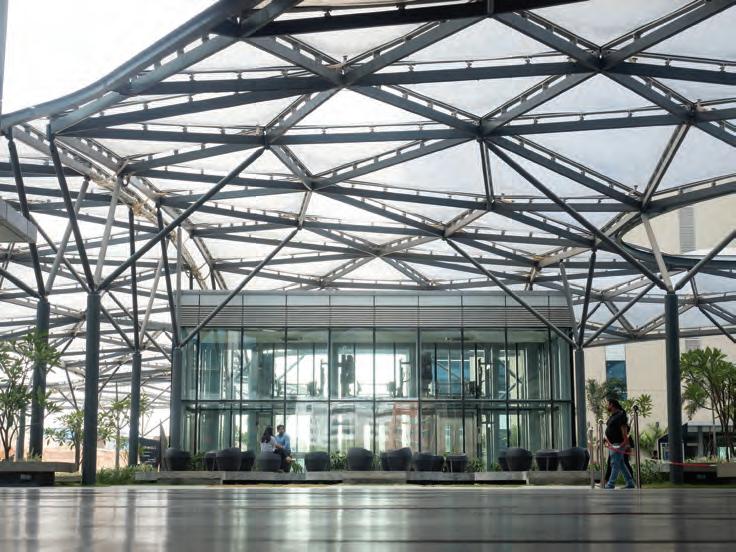

BIJAY AGARWAL
Managing
Director, Salarpuria Sattva Group
Bijay Agarwal is the driving force behind the Salarpuria Sattva brand, who is responsible for many quality projects in commercial, residential, IT parks, hospitality and retail sectors spread across India. He is acknowledged as a ‘trendsetter and leader in the real-estate industry.
shopping experience. This has led to last-mile delivery with city-specific local warehousing touchpoints. In the years to come, last-mile delivery warehousing will become a common phenomenon with more and more players adopting it countrywide. CONCLUSION
As aforementioned, the industry projections and trends suggest that the future of Indian real-
estate not only looks bright but is set to move up the ladder in the coming years. Several dynamics will continue to impact the multiple façades of the real-estate industry, to name a few: prices, buyer behaviour, demographic shift, cost of raw materials in general. Therefore, it can be said that affordable, self-sustaining properties with a consumer experience-centric approach are the future of the real-estate for at least the next 5-7 years.
Agarwal completed the Presidents programme from Harvard last year. He has won several recognitions and awards. A financial wizard, he formed strategic partnerships with top international players for realestate investments. The Group has a CRISIL ‘A’ Stable Rating, which is one of the highest financial ratings for any realestate company in India.
Bijay Agarwal is the Founder and Chairman of the Greenwood International chain of Schools. The company diversified into Aero Accessories business and the IT sector too.




The Indian real-estate sector like any other sector has seen an interesting turn of events on account of Covid-19.
With the onset of the year, the real-estate market was set for a quick comeback buoyed by lowinterest rates, a fall in the number of covid-19 cases, news of vaccine rollout, stamp duty cuts, and a slew of attractive payment options.
However, as we saw a steep rise in the number of cases from April 2021, the nation suffered its worstever crisis and as a result, the realestate market also plunged.
As normalcy is restored, the real-estate market shows signs of optimism. The real-estate stocks remain bullish with signs of demand revival in both residential as well as commercial space.
The Indian real-estate market shows strong signs of optimism and recovery in 2021 after a series of headwinds which include a 2016
surprise cash ban, bad-loan crisis, and the covid-19 pandemic.
government and the industry need to work in tandem on creating a

INFRASTRUCTURE PUSH IN 2020-21
The Indian real-estate market constitutes around 8 per cent of the GDP and is the secondlargest employment creator after agriculture.
With a workforce of over 40 million directly dependent on the sector, strained real-estate is bound to have a cascading effect on the economy.
As the market shows more favourable economic trends, the
strong infrastructure pipeline.
While RBI’s accommodative stance alongside liquidity injection has eased home loan rates, further concentrated efforts like stamp duty reduction in states of Karnataka, Maharashtra and Delhi have eased consumer woes.
With the Model Tenancy Act (MTA) expected to be operational soon, the Indian rental market looks to become standardised thus drawing institutional players to this category.
What’s also important is taking care of the employees and vendors both in terms of bodily and financial health. Another step is offering vaccine packages to employees amidst such a medical crisis.
Government and the industry need to work hand in hand to develop technological innovation. Via subsidies and policy incentives, the latest technological developments should be deployed, and a hybrid workflow should be adopted.
The use of video conferencing and online visual tours should be looked upon as an alternative to entice new consumers. Adoption of data mining techniques to unlock consumer buying patterns and habits is the way to keep the guesswork out and truly understand consumer purchase behaviour.
Backward and forward integration, optimization of operational workflow and research led by academic institutions should also be focused upon.
While there is no dearth of housing demand in the country, aggressive sales and marketing planning without any incremental costs is required.
Looking ahead, this time around, the real-estate sector will remain risk-averse. Firstly, with controlled cases, most rating agencies have not cut down on the prior aggressive growth numbers of India.
Despite the cyclic slowdowns, the structural demand is robust which stems from the rise in disposable income, young demographics, and a large urban-centric population.
Secondly, plenty of first-time homebuyers are looking out for a home. Similar is the case with households looking to move out
and obtain larger houses.
Thirdly, lower housing loan rates further attract consumers and add impetus to the market.
The economic outlook for FY 2022, looks promising with 360 Realtors view research suggesting an overall positive economic outlook and most rating agencies correcting the forecast GDP numbers in the range of 8 to 9.5 per cent.
The home buying sentiment looks sold at 30.7 per cent of buyers looking to buy a home. The 360 realtor survey also suggests that a visible segment in the market is looking to upgrade.
market is expected to grow from USD 1.72 billion in 2019 to USD 9.30 billion by 2040.
The ICRA estimates Indian firms to raise USD 48 billion via InVITs and REITs in 2022.
Retail real-estate along with the warehousing segment attracted USD 220 million and USD 971 million in 2020 respectively and the office space segment is expected to cross USD 700 million by 2022.
The government is taking several initiatives to encourage sectoral development.
Tax deduction of up to Rs.1.5 lakh
SETTING STAGE FOR GROWTH AHEAD
As per the India Brand Equity Foundation (IBEF), the real-estate
on interest on housing loans and tax holidays has been provided by the Union Budget of 2021-22. Under the Atma Nirbhar Bharat
Priorities2020 2021
1 Securing a comfortable salaryWorking in a company which ensures health & well-being
2 Having a great work-life balance Having a great worklife balance
3 Working in a company which ensures health & well-being
Package 3.0, the government has provided income tax relief measures when it comes to the primary purchase and sale of residential units of up to Rs. 2 crores.
To deal with stalled housing projects, the Cabinet has approved the setting up of Rs.25,000 crore alternative investment fund and has also created an affordable housing fund in the National Housing Bank with a corpus of Rs.10,000 crore.
The residential sector is also expected to grow significantly with the central government aiming to build around 20 million affordable houses by 2022.
Regulatory body SEBI has lowered the minimum application value for Real-estate Investment Trusts (REITs) from Rs.50,000 to Rs.10000-Rs.15,000 making the market more accessible to both small and retail investors.
The IT spending in real-estate is on an upturn. Similarly, with the
Securing a comfortable salary
anticipation of the third wave, realestate advisories look to spend more money on cloud-based services, remote working software to ensure seamless service in the face of a crisis.
The use of cloud-based technologies has already illuminated real-estate players about big-data sets. Now integration with machine learning software and Artificial Intelligence (AI), the game of data analytics can help in the systematic evaluation of a large chunk of alternatives to find the best fit.
Moving forward, the investment in real-estate needs to be backed by long term strategic interest to build a solid foundation for the future.
Government support, industrial sector initiatives and use of technology can play a pivotal role in simplifying the transaction cycle, driving engagement, and improving the ROI significantly.

SANYA AEREN Chief Advisor, Marketing & Communications, Berkshire Hathaway HomeServices Orenda India
ABOUT THE AUTHOR:
A marketer, communicator, entrepreneur and altruist, Berkshire Hathaway HomeServices Orenda India’s Chief Advisor, Sanya Aeren is the forthcoming icon in the marketing industry. Sanya is also the co-founder of the two companies in the jewellery as well as the healthcare sector.
With a Degree in Media Communications from Stanford University, California and a marketing certification from Kings College, London, she is known to be a person with intense zeal and a highly focused approach. Infused with enthusiasm, she is determined to lead by example in an otherwise male dominant realestate industry.

“The
Architectural hardware plays an inevitable role in the construction industry, whether it is residential, commercial, or industrial. Every infrastructure is
incomplete without architectural hardware, and this raises the demand for architectural hardware market. The presence of several international and domestic hardware products in the market, along with urbanisation fuels the growth of this market sector.
Advancements in technologies, increased real estate investments, amplified infrastructure projects such as residences, schools, hospitals, airports, etc, are immensely contributing to the

growth of the architectural hardware market. The construction activities carried out in emerging nations such as China, Japan, India and others are heavily demanding for the architectural hardware that further drives the growth of this market.
The first wave of covid-19 created a decline in residential sales. However, the impact of the second wave was partial. Despite states imposing lockdown, the developers launched projects across major cities, out of which the majority was in the affordable and mid segments. The upliftment of restrictions and successful vaccination drives acted as a catalyst to the growth of the market, compensating for the initial decline.
As per the market response, the market is expected to reach precovid levels by the end of 2021. IMF has projected that India’s economy will grow at a rate of 12.5% and in 2022, the growth will be at 6.9% which is higher than the projected growth of China at 5.6%.
In comparison with Q2 2020 to Q2 2021, there has been a growth of about 83% in new launches of residential projects, parallely, the sales growth of inventory have also grown to 83% when compared to year over year. This is indeed a great sign for the fenestration industry as a whole. Functional experience centres with real operable samples of windows and doors are installed, to demonstrate the applications of the hardware and accessories, thereby giving a ‘look and feel’ experience to the buyers. From


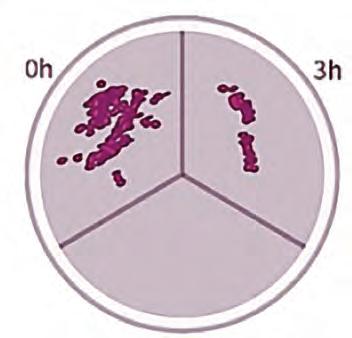
the conventional hasps made of metal bars to secure doors and window panels, now there has been a drastic drift to smart locks and hardware utilising the advancements in technologies. The present era customers are educated and well aware of the significance of having a sealed and secured door/window in their infrastructures. Façade consultants and architects are playing a vital role in creating this awareness among the consumers. Though there has been a decline
universally for any industry due to the pandemic, it had also given rise to new developments in the industry, One such remarkable development is the anti-bacterial products series (a special surface treatment on the products to prevent oneself from touching it and causing bacterial infections).
Like any other industry commercial sector also witnessed a sharp decline from 2020-2021, However, Q2 2021 has shown significant














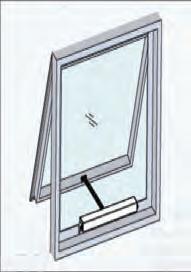





























Irfan Wasil, Zonal Manager for Karnataka region (Head office) is associated with Kin Long for over a half-decade. He started his career in Kin Long as a Sales Engineer in 2016 and at present serves as Zonal Manager. Kin Long is one of the largest hardware manufacturers in the world of its kind serving the industry for more than 45 years. In India, Kin Long has 13 branches including all metropolitan cities. Kin Long India at present, owns three warehouses, one in Bangalore, others in Mumbai and Delhi respectively. Kin Long is unique with the manpower strength and in house design, business development and product specialised departments aimed at catering the clients with top-notch service levels and improving the living standard of common people.

growth in this sector. In recent times, high-rise residential building envelopes started incorporating glass façades which is a positive ray for the façade industry. The façade industry is expected to rise at a considerable rate between 2021 to 2026. In 2021 the market was growing at a steady rate and with the strategies trend adapted by the major players in the market, growth beyond the expected horizon is foreseen in the near future. A rising focus on developing sustainable products would work in the market’s favour. The concept of green buildings and the rising demand for highly transparent glasses that would allow light and resist heat are poised to shape the future of the façade industry.
Façade being looked at from just an aesthetic point of view has now become a source of revenue for the consumers with the innovations brought by the major hardware manufactures.
One such remarkable innovation has been the transparent LED screen incorporated in the façade to advertise or display any content of consumer’s choice which creates awareness among the public and help the owner generate income.
In early 2020, we could see a markable decline in both fenestration and façade industries like any other industries mainly due to the pandemic impacts, However, since Q2 2021 there has been a significant rise in both the industries as the restrictions were relaxed and markets were open. The residential building launches increased drastically and the commercial sector also showed remarkable growth. Foreign investments in the country and innovations in both fenestration and façade sectors are indicating good growth prospects in the coming years.


As a veteran in the field of sealants, PU foams and building hardware accessories, I can truly give you my in-depth understanding of what India has witnessed in the past couple of years and the future of the façade & fenestration industry in coming years.
PU FOAMS AND SEALANTS
I would like to break up the subject of sealants and PU foams first…
The humble beginning of the sealant industry: Use of Silicone mainly started with Silicone structural glazing way back in the early 1990s. Silicone now is a ‘must have’ for every façade, door and window aka fenestration. The

revolution in the silicone industry came with the advent of uPVC doors and windows in early 2000 and now after two decades, it is mandatory to use the same in every door and window installation.
The organised aluminium system companies also shaped the use of silicone sealants. This has also urged the unorganised aluminium
door and window industry to a large extent to make sure to use Silicone sealants, acrylic sealants and PU Foams for all installations across the country.
In particularly, a fenestration includes a complete system with all mandatory components including profile, glass, gasket, sealant, anchors, fasteners and reenforcement. They all go together as one to complete the system.
Thousands of trainings organised for industry members along with demos on proper installation/use of all these products has shaped the sealant and fenestration/related industries in India. Looking ahead, the construction industry in India will take a long forward leap jump in the coming years. Projects and retail sectors are expected to keep growing through the decade and I see that the growth of sealants is






directly proportional to the same. Quality is a top performer and will be needed to be maintained by all manufacturers at all times to have enduring products with high performance. I also see great scope for new technologies like MS Polymers and Advanced PU to come forward in the industry sooner.
India is a dream shaping up and sealants is a form and function of the same, growth can only be positive.
As far as building hardware and accessories are concerned, for the longest time, the same was always imported from China and other parts of the world and still is. Going forward, the forward drive
towards ‘Make in India’ is going to take shape very aggressively and it is expected that top quality uPVC/ Aluminium door and window hardware will be produced in India, not only for the domestic market but also for exports.
The consumption of quality hardware is likely to double every year and the industry size to even grow more than 30 % year on year as more and more doors and windows will need more safe and secure hardware, which in turn means more hardware per window and door in terms of cost and value.
India is on the growth trajectory and we welcome this change and will support the industry like have been doing for the past few decades.
Amit Malhotra is a well-known personality in the silicone and building products industry in SAARC nations. Amit joined the family business of waterproofing started by his late father Mr VK Malhotra in 1993. From its humble origin, McCoy Group has come a long way and has offices in India and abroad and sourcing offices globally, with an annual turnover of more than 150 crores. Amit is the Marketing Head & Treasurer of uPVC Window and Door Manufacturers Association, known as UWDMA, and was also the President of the Confederation of Construction Products and Services (CCPS) for many years. In his professional life, Amit has chaired many committees of various industry’s associations.
Covid had hit hard not only India but the whole world.
This Pandemic has affected most businesses. At the top of it, the prices are skyrocketing today. The price of PVC increase is 120 %, Steel from Rs 72 to Nearly Rs 100; other materials like Zinc, Aluminium increased by 40%; fuel at its top at Rs 110; container charges from China is today is $10,000, which was $1800 a year back. So the enduser which is the ultimate buyer has to shell out nearly 30% more and it is not stopping till now.
Well, as far as demand is concerned it is definitely back, rather increasing. India is a developing country and a growing economy. So COVID can give a short term pain but no one can stop India’s gain.
The GDP collection in October 21 was at whooping Rs 1.3 trillion

from 1.05 trillion in last October (2020) which itself says around 30 % of growth. The construction industry has given 20% GDP growth in the last quarter. BSE is at its best at 60,000. So Indian economy is gaining momentum. Whatever loss has been incurred in the fenestration Industry during the lockdown 2020 and 2021, it

is already in the path of recovery and the requirement today is at its peak.
The total fenestration Industry stands at Rs 30,0000 Cr and As far as uPVC is concerned it should be nearly at Rs 3500 cr and consumption of Profile is approximately at 80,000 T of profiles. We did not see growth in 2019 -20 to 2020 -21 but at end of 21-22, we are expecting 10-15 % of growth for the industry.
Hardware plays a major role in doors and windows. It is not only important for smooth operation but also the aesthetic looks. Hardware gives you proper sealing, ventilation, waterproofing, multilocking, etc. So it is very important to choose the right hardware not only in terms of quality but also according to application. Here are some important criteria to be followed:





1. Selection of Hardware: This is one of the major criteria that how and which hardware to be selected for the particular window /Doors. There are numerous profile sections, and hardware can be different for the profiles. Wrong selection of hardware can lead to failure In operating the windows. So it has to be selected according to fitment on that particular profile.



There are instances where the buyer of windows have selected expensive profile but because of the wrong selection of hardware, the window could not be operated well. So the whole purpose is defeated.
2. Quality of Hardware: It is a very important criterion. Before Selecting the hardware one need to check the certification from the manufacturers. The major ones are the operating cycle test which should be 25000 cycles whether it is multi locks, handles, rollers, etc. Further, there are different weather conditions in countries - so Salt spray check is a very important criterion. It should pass at least Gr3 ( 240 hrs) and the best could be Gr5 (480 hrs). It is recommended to use SS 304 in Coastal Areas and sometimes even SS 316 if the site is Just near to the beach. Please refer to the below chart.
3. Application/Fitment of Hardware: Once we select appropriate hardware with the best quality, then comes the proper fitment on the window/ doors. Workers have to be skilled and trained for that. They should use proper Jigs for the fitment, and position of rollers to be taken care of, size of the multipoint lock should be as per the height of windows, etc.
Once we follow the above three criteria then we can make perfect windows/doors.
In the end, I would like to say that with Covid cases dipping and vaccination increasing the future for the hardware industry is very promising. It is the right time to invest, so companies can make a good profit in the next decade.
Vikas Malhotra is a BE (Mechanical) graduate and did his MBA From Amity Business School. After working for 2 years he pursued the Entrepreneur Course from IIM - Lucknow. Before starting his venture ‘DNV’ along with Naveen Jain in 2008, he worked with a few companies in India and Abroad. He could foresee good demand in the uPVC industry and accordingly started uPVC hardware manufacturing. Today DNV is one of the top hardware companies and their products are approved by mostly all profile companies. DNV is now coming up with a much bigger unit with a lot of atomisation and it will be fully operational by January 2021. With this new unit, DNV will be able to further improve their product’s qualitiy and consistent supplies.



The manufacturing industry is building back fast post lockdown; so is façade and fenestration industries, undismayed by significant labour and supply chain challenges, raw material price variations, and reduced margins. To maintain the momentum, manufacturers should navigate elevated risks while advancing sustainability priorities.
Optimism around revenue growth found in 2019 was held in check by the pandemic 2020. Labour shortages and supply chain instability were reducing operational efficiency and margins, which is still a problem. Another shortfall was seen in skilled manpower, which is affecting productivity. A report by Deloitte, one of the top global consultancy firms, points out that last year they estimated a shortfall of 2.1 million skilled jobs by 2030. “To attract and retain talent, manufacturers
WFM Media interacted with many industrialists and influencers to understand the present market situation and to know their outlooks and hopes for the decade. We also discussed manufacturing industry trends that can help capture growth and meet the rising demands.
should pair strategies such as reskilling with a recasting of their employment brand. Shrinking the industry’s public perception gap by making manufacturing jobs a more desirable entry point could be critical to meeting hiring needs in 2022. Engagement with a wider talent ecosystem of partners to reach diverse, skilled talent pools can help offset the recent wave of retirements and voluntary exits,” infers the report.
Manufacturers are looking to capture growth and protect long-
term profitability. To achieve this, the companies should embrace digital capabilities from corporate functions to the factory floor. More organisations are making progress with digitalisation, seeing results from more connected, reliable, efficient, and predictive processes at the plant.
The growth of the façade and fenestration industry is complemented by the growth of the real-estate sector in India and around the world. The real-estate sector is one of the most globally



Bharati Vidyapeeth Multi-speciality hospital, ALUCOMET FABRICATORS
recognised sectors. It comprises four sub-sectorshousing, retail, hospitality, and commercial.
In India, the real estate sector is growing with a CAGR of 30%, making it an opportune market for investment currently. By 2040, it is predicted that the Indian real estate market will grow to Rs. 65,000 crore (US$ 9.30 billion) from Rs. 12,000 crore (US$ 1.72 billion) in 2019.
The real estate sector in India is expected to reach a market size of US$ 1 trillion by 2030 from US$ 120 billion in 2017 and contribute 13% to the country’s GDP by 2025. Retail, hospitality, and commercial real estate are also growing significantly, providing the muchneeded infrastructure for India’s growing needs.
As per ICRA estimates (an Indian independent and professional investment information and credit rating agency), Indian firms are expected to raise more than Rs. 3.5 trillion (US$ 48 billion) through infrastructure and real estate investment trusts in 2022, as compared with raised funds worth US$ 29 billion to date.
The pandemic dealt a major shock to the housing market with prospective buyers postponing their purchase decisions. However, the situation has improved since May 2021. As per a report on the Indian Real-estate industry by IBEF, housing launches were 86,139 units across the top eight Indian cities in the second half of 2020. Home sales volume across eight major cities in India jumped by two times to 61,593 units from October 2020 to December 2020, compared with 33,403 units in the previous quarter, signifying healthy recovery was observed post the strict lockdown imposed in the second quarter.
Various industry bodies have predicted trends of 35%-40% growth in both new launches as well as sales in this end quarter of the year 2021. Data shows, as many as 24,600 units were sold across the top seven cities in Q2 2021, while 36,250 units were launched in the same quarter.
While there is still a long way to go, the worst is behind for the residential segment. A combination of favourable factors such as low mortgage rates, stable prices and flexible payment plans of developers make this an appropriate time for buyers to strike a good deal.
The government of India along with the governments of respective states has taken several initiatives to encourage development in the sector. The Smart City Project, with a plan to build 100 smart cities, is a prime opportunity for real estate companies. The residential sector is expected to grow significantly, with the central government aiming to build 20 million
affordable houses in urban areas across the country by 2022, under the ambitious Pradhan Mantri Awas Yojana (PMAY) scheme of the Union Ministry of Housing and Urban Affairs. Expected growth in the number of housing units in urban areas will increase the demand for commercial and retail office space.
Let’s look at the market for various products which goes into building façades and fenestrations.
Architectural Cladding Materials: WFM Spoke to Atharva Moroney, Founder, ALUCOMÉT Fabricators, on the architectural glass/cladding materials business and market for various architectural cladding materials in 2020-2021. According to him, the architectural cladding material business has grown by multi-folds

in the past 5-6 years, but as per his belief, it is probably the only area in the façade industry that has seen tough competition in terms of technical aspects, aesthetic appeal and finally - war zone like commercial pricing. Earlier, it was predominantly only the ACP sheets that used to govern the actual cladding market. “I believe
I had read in some article wherein if I recollect the figures. The share of ACP cladding alone was around 3000 Crores. But gradually over the period, the architects who are also considered as the ‘Captain of the ship’, which in other words in nothing but the ‘Project’ itself, decided to experiment with other cladding materials. Thus they started testing their hands with elements like Metal claddings, Zinc, Copper and Corten claddings, etc. and then eventually even stone claddings were brought into use on a very large scale,” says Moroney.
According to Dr. Prashanth Reddy, Managing Director, FunderMax India Pvt. Ltd., the overall façade and cladding market is at an estimated 100 million square meters. The growth rate in the past was at 12-18% and the demand is rising because of an increase in awareness about

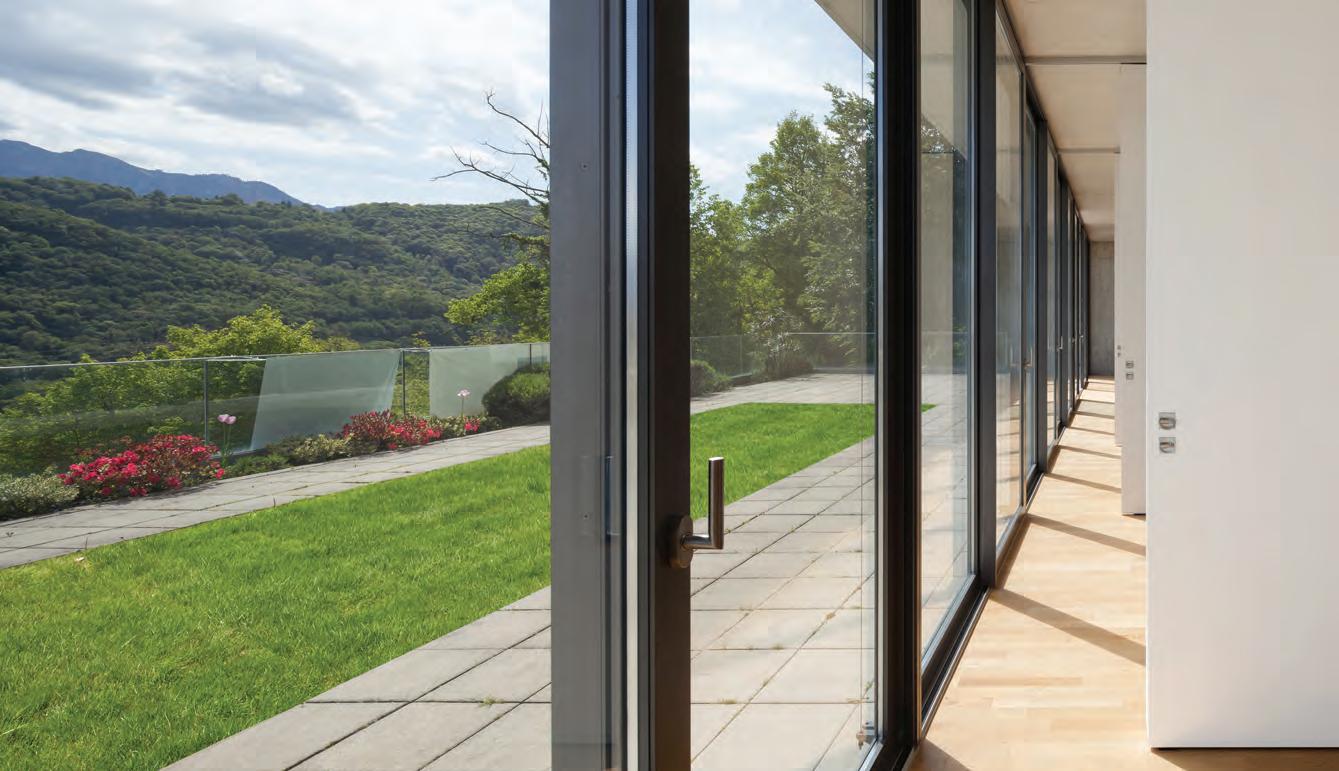





Delhi Office: 4899 Hauz Qazi, Delhi-110006
Head Office cum Application Centre: 28/01/8, Site IV, Sahibabad Industrial Area, Ghaziabad (UP) - 201005 For Sales: West: 8929070625 l North: 8929070621 l East: 9319623434 l Karnataka: 9999697660 Tamil Nadu & Kerela: 8929070623 l Andhra & Secunderabad: 8929070624

Coimbatore Office: 2/227 D Erangathu Thottam, Rasipalayam Sulur, Coimbatore-641402 Website: www.pego.in


cladding, not only for aesthetic but also for functional values.
The cladding market is quite mature now and is filled with options that are new and innovative. In the past, glass, stone, wood, metal/ACP has always been the traditional choice of material for exterior cladding. Reddy also observes that materials such as exterior grade laminates, (as per EN438-6), Fiber Reinforced Concrete, Metal Claddings (Zinc, Copper, and Steel) are more preferred by the clients.

The Indian housing sector is set to undergo a momentary phase of trouble but looks to emerge stronger as we step into a postCovid world. With the increase in construction requirement and factors such as fast-depleting natural resources, achievement of Sustainable Development Goals (SDGs) & international commitments to reduce carbon
footprints, the Government of India’s Ministry of Housing & Urban Affairs recognises that there is an urgent need to find a substitute for energy-intensive building materials and minimise the use of scarce natural materials.
India is expected to witness strong growth in the green building sector with increased awareness and demand for green building materials in residential projects,




MUTHU KUMARAN
Deputy General Manager, Head – Façade & Roof Division, New Market Development, Wienerberger India

DR.H.C MARIO SCHMIDT
Managing Director, Lingel Windows and Doors Technologies Private Limited

NIKHIL JAIN
Director, The Rishabh Winpro Pvt Ltd
states Muthu Kumaran, Deputy General Manager, Head – Façade & Roof Division, New Market Development, Wienerberger India. On the demand side, there’s expected to be an increase due to pent-up demand bolstered by the accelerated pace of vaccination. The growing

need for homeownership and slow momentum gained in employment is driving housing demand. Energy-efficient homes are gaining traction and the concept has a dominant influence on the minds of prospective home buyers, adds Muthu Kumaran.
In the clay ventilated façade tiles for cladding, there’s a perennial need for a timeless modern façade with the distinctive character of natural clay. The organised construction market has remarkably used this opportunity to create a signature style element for their design ethos by experimenting with façade materials that define their offerings. In the modern context, a building must be sustainable, energy-efficient and each architectural design must offer a benefit. Especially when it comes to smart cities, the buildings must project a sense of intelligent design to abide by the overall city planning.
Covid -19 had its own repercussions and that was felt in the fenestration industry as well.
When the markets opened there was a surge in demand, says Dr.h.c Mario Schmidt, Managing Director, Lingel Windows and Doors Technologies Private Limited. This lead to a shortage of raw material and a surge in the price of raw material was witnessed. Needleless to say, the cost to hire skilled workers also rose as many had left for their villages, says Schmidt. “We saw a real need for customers to invest in good quality products and services and the demand for Aluminium rose compared to uPVC. This inflation in the raw material is currently a concern which we are hoping will be controlled,” he hopes.
Nikhil Jain, Director, The Rishabh Winpro Pvt Ltd adds that with the increased time spent by people in home during Covid times, the manufacturers have witnessed the increased need for good performance doors and windows from consumers. They want elements that increase light, reduce noise, heat, pollution with no air leakages and are longlasting and easy to operate. Ultrapremium customers are inclined towards aluminium doors and

windows with even thermally broken and premium finishes like wood, bronze, copper finish, whilst premium and economy customers are moving towards uPVC and not just white but also with foiled lamination, observes Jain.
According to Pulin S Rajyagor, PVC Business Head, Reliance Industries, the Indian uPVC window & door industry is poised to a high growth trajectory. This industry is closely linked with the infrastructure sector and Indian infrastructure growth potential is beyond any doubt. Acceptability of uPVC window & door is going to augment due to various technical superiority, low maintenance, and design flexibility. However, the penetration level of uPVC in India is very low and that is why there is ample opportunity to grow. Moreover, the Prime minister’s vocal for local and self-reliance stand would catalyse Indian manufacturing activities and infrastructure would be one of the most promising ones, Rajyagor is optimistic.
After 18 months of Pandemic, clouds of uncertainty have started disappearing complimented by the fastest vaccination drive. The architectural hardware industry has also witnessed a steep rise in transport & raw material costs such as aluminium, steel, etc.
“Although most of the hardware companies have been successful in not passing the entire burden to end clients and keeping the pace of the project going with a marginal increase in hardware budgets, leading to clients getting more inclined towards working with the organised hardware companies, observes Hemant Kathuria, Director – Taiton Overseas.
A lot of people took the slowdown as an opportunity to renovate their existing properties (mostly seen in the hospitality sector), thereby creating strong demand for architectural hardware. We have also witnessed the increased usage of luxury hardware in the middle to high-end residences in the past few months, adds Kathuria.




Every fall comes with a rise… The architecture & design industry, much like any other service industry, came under severe pressure and hurdles during the pandemic. With projects delayed, new leads on a standstill and clients pulling back budgets, the only mantra that resonated with independent design studios was ‘Survive and then Revive’. Issues from every facet of the
business such as tight finances, retaining team strength, increased infrastructure costs and low project inflows plagued the industry. However, with this grim situation came new realisations and opportunities. We witnessed the strength of our team, who managed to get projects executed and completed even during the tough lockdown period.
Also, this was a period of reflection among the design industry and many clientele as well. A sense of pause helped us to reimagine what the spaces of tomorrow should offer. As people, lifestyles and interests underwent a drastic change, spaces needed to adapt to this new normal and with it came to a sense of exploration

and innovation in architecture and interior design. New sensibilities and empathy are crucial to public spaces today, including retail environments, that make people feel safe and comfortable.

With the period of new learning and hardship, we were able to cross the turbulent second wave this year. Soon, new leads and the projects on hold started to come in and progressively increased. However, there is a sense of caution among clients and with it the tight budgets and timelines. We feel that the time of revival is kicking in and are confident that this upward climb is here to stay. It’s definitely an interesting time to witness the ‘revolution’ in the design industry and be part of it.

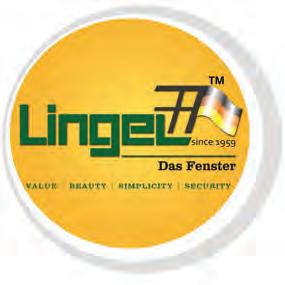

Let’s see how the architectural cladding industry will progress in this decade and the factors which will drive the industry’s growth.
Dr. Prashanth Reddy from FunderMax India Pvt. Ltd., is definite that sustainability is going to be the buzz in the coming decade. Most projects would seek green-certified products. This will significantly increase the market demand for efficient cladding materials & systems such as exterior grade laminates and their use in the revolutionary rear ventilated façade system. For instance, in this case, the differentiating advantage of exterior grade laminates is eco-friendliness, thermal efficiency, energy renewability, and sustainability.
Atharva Moroney, from ALUCOMÉT Fabricators too agrees with Reddy. According to Moroney, this decade will be witnessing some outstanding and excellent out-ofthe-box material finishes, which would be introduced to the market. “As far as I believe by observing the trend in which the cladding industry is inclined, the conventionally used aluminium composite panel sheets are seen to be replaced by actual metal sheets. The traditional stone cladding which adds to the weight of the main structure due to its weight and density are seen to be replaced by lighter and long-lasting honeycomb panels and minimalistic thicknesses of compressed porcelain slabs which will be thinner than 05mm in thickness, “predicts Moroney. Moroney adds that he is in touch with some outstanding technocrats of the manufacturing industry and they seem to have a totally different vision towards the cladding material industry. At the same
time, companies are talking about engineered stones and engineered wood, which shall have all the properties (Mechanical & Physical) same as the natural materials but with an enhanced range of properties and shelf life. Also, very importantly, we as a part of the process are talking about emerging as a cleaner and greener industry with lesser carbon footprints left behind during the production of these materials we are dreaming about to take up the skyline of our cities.
The cladding segment is also witnessing growth albeit at a slower pace, considering the slowdown in commercial construction. Architects prefer natural products with longevity complementing
glass & other modern materials. The widespread adoption of natural cladding materials not just in commercial spaces but also in IT parks, public utilities and hospitality would be the key drivers for growth. The renovation market also holds promise in cladding as we have seen an uptick where existing structures with ACP are moving towards cladding them with clay façade tiles. Resource-efficient clay bricks can significantly address many of the growing needs for green building materials and also cater to the demand from the single-family homes in Tier 1 and Tier 2 cities, says Muthu Kumaran from Wienerberger India. Lightweight & green products are increasingly gaining acceptance. Developers are showing a growing interest in attaining LEED (Green) ratings for their projects. “We see a huge potential in the cladding &


roofing segment as well for the clay building as the market preferences are changing post-Covid and preference for villa and individual home projects are increasing. This trend is particularly common in South India. Our tropical climate demands a pitched roof in this segment. New flat roof tiles designs are a preferred choice for contemporary design,” adds Muthu talking about the trends.
It is rather difficult to predict what
this decade would look like and if businesses will adjust to the new normal like it is doing now. The future seems fine as long as there the situation is under control. Price rise can be expected in the near future to maintain stability, warns Dr.h.c Mario Schmidt from Lingel. The future of this industry will be safe if it maintains and safeguards the standards for the products, points out Mario. Keeping in mind the Glasglow conference, he adds, it is the need of the hour to have eco-friendly products. It has already been agreed at COP26 where
more than 100 world leaders have promised to tackle deforestation, and the industry must work in the same direction for the future, advises Mario. He recommends standard, sustainable quality products.
Doors and windows have great importance in the minds of the consumer while planning for a new house or renovating the existing buildings. According to Nikhil Jain, the demand for performance with emphasis on tested systems is also going to rise. The shift from simple sliders or casements to solutionoriented products like Lift n Slides, Fold n Slide, Tilt n Turn will also gain prominence. Reliability & sturdy performance with solid warranties and after-sales service support will be key for success in future of the fenestration industry. Innovative finishes and options both in Aluminium & uPVC will be exciting for the consumer.
Infrastructure development is the barometer of any country’s economic health and India is no exception. Govt. of India has been pushing for infrastructure development for many years and would continue to do that in several decades. With that thrust and PVC being a truly infrastructure material, the future of PVC and uPVC windows remains bright, adds Rajyagor from Reliance Industries.
From a sustainability aspect, uPVC is nearly unmatched. uPVC is a perfectly sustainable building material being 100% recyclable and having the lowest embodied energy when compared to other popular building materials like steel and aluminium. uPVC windows help in conserving energy and are longlasting to the tune of the life of the building, adds Rajyagor. Although uPVC window and door is relatively expensive than traditional material, demand for the same is gaining momentum and would continue to get the tailwind. Consumers started


Email:

taking a holistic view of the overall benefit rather than looking at only price.
Architectural Hardware Industry, being strongly influenced by architects & interior designers, is already going through a transformation with the strong demand being created for Niche & Exclusive Products, states Nageswara Reddy, MD – Taiton Hardware Pvt. Ltd. There is a need to continuously innovate and introduce latest technology products into the market to meet the demands of unique and longlasting products.
“Off late the clients are getting more aware of hardware functioning and are careful in selecting the right hardware for their spaces. They also evaluate the quality being offered very cautiously and don’t mind
shelling some extra bucks to get a superior quality product considering the Long term advantage,” explains Reddy. Future belongs to the hardware companies which will perform consistently on the product quality, innovation, availability & service, he concludes.
The prospects for the façade and fenestration industry in the immediate term remain relatively good, although a volatile economy casts some uncertainty over short term prospects.
The performance of the façade/ fenestration industry would be proportionate to the performance of the Indian real-estate sector. The Securities and Exchange Board of India (SEBI) has given its approval for the Real Estate Investment Trust (REIT) platform, which will allow all kinds of investors to invest in the Indian real estate market. It would create an opportunity worth
Rs. 1.25 trillion (US$ 19.65 billion) in the Indian market in the coming years.
The residential sector is expected to grow significantly, with the central government aiming to build 20 million affordable houses in urban areas across the country by 2022, under the ambitious Pradhan Mantri Awas Yojana (PMAY) scheme of the Union Ministry of Housing and Urban Affairs. Expected growth in the number of housing units in urban areas will increase the demand for commercial and retail office space.
Based on the comments from all the industry leaders and reports, we can come to an inference that the Indian Window, door and façade market would will vroom again, if the manufacturers stress upon maintaining quality, testing, certification while advancing technologies including digitalisation and sticking on to sustainability priorities.
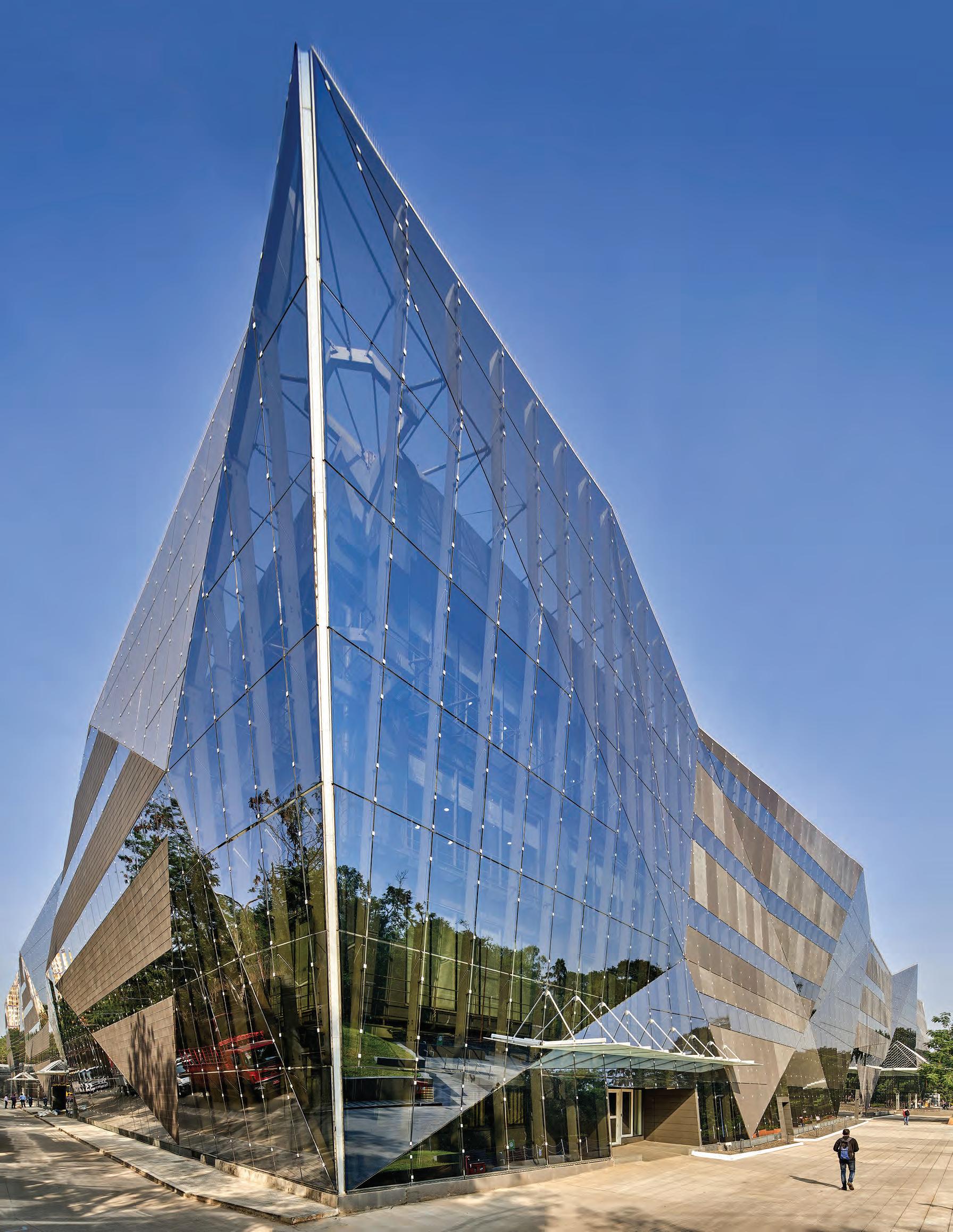

THE SYSTEM:
• Patented curtain wall system
• Long spans
• Elimination of horizontals
• High transparency
• Complex geometries
• Versatility
• Superior thermal performance
• Jumbo glass sizes
• System material options: aluminum, glass, & timber
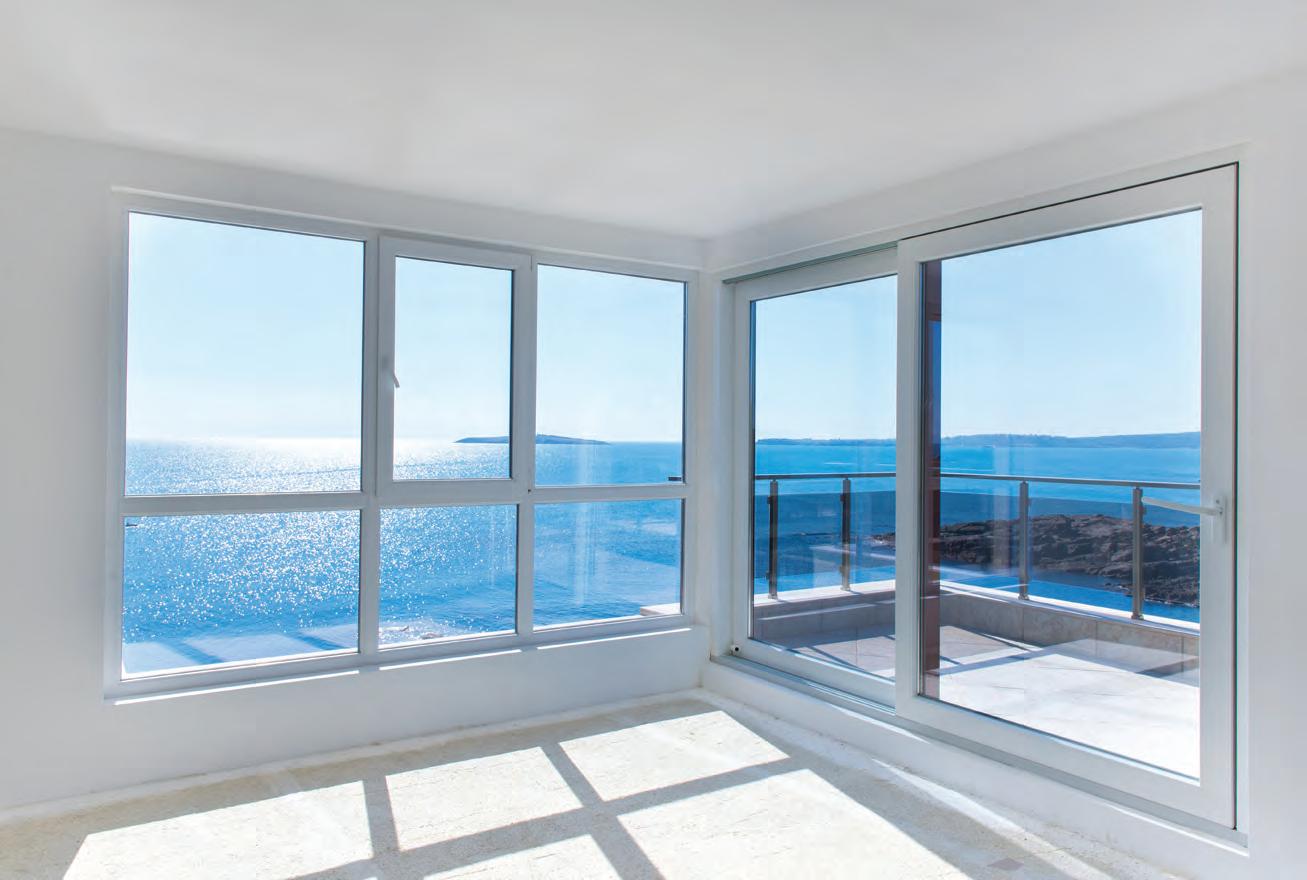
“uPVC Windows & Doors are the Best Bet for Your Projects”

SANJAY MEELA Director, Sudhakar Profile Systems
Sanjay Meela is the Director of Sudhakar Profile Systems. With his strong entrepreneurship skills is leading the organisation towards growth. Being 3rd generation entrepreneur from a family which has a legacy of 50+ years in PVC industry, Sanjay carries vast experience with proven accolades in sales and marketing, supply chain and operations, strategic business planning, product management and development.
Sudhakar Group was established in 1971 at Suryapet, Telangana and is one of the leading pipes brands in India with more than 3500 dealers and distributors network. The company has a wider product range of- pipes and fittings, wires and cables, and uPVC Profiles for windows and doors.
The vision of Sanjay Meela is to be a leading profiles brand in the fenestration industry, and service tier-2 & tier-3 markets effectively. Additionally, developing innovative products and scaling up the production capacities to meet the supply demands.
In a dialogue with WFM Media, Sanjay Meela explains his journey with Sudhakar Group, the products and services from his company, his company’s association with the fenestration industry in India and their contribution towards the growth of the sector, and the company’s future expansion plans.
Please tell us about your company Sudhakar Group and yourself? How long the company has been in the uPVC door and window business in the Indian market?
Sudhakar Group was established in 1971 at Suryapet erstwhile Andhra Pradesh, now in Telangana by Shri. Meela Satyanarayana. Today, Sudhakar Group is a 50-year conglomerate, with a diversified product range of pipes and fittings, wires and cables, and uPVC profiles for windows and doors. I am the third generation from the family and associated as the Director of Sudhakar Marketing Agencies Pvt Ltd. I am wholly involved in sales, marketing, branding, production, operations and the supply chain of the two new verticals, Sudhakar Wires and Cables and Sudhakar Profile Systems. We started with the fabrication of uPVC windows and doors in 2015. Later, in 2017 Sudhakar had launched its extrusion unit with a state-ofthe-art facility at Gudur, Andhra Pradesh, to supply class-leading uPVC profile systems for windows and doors.
When have you joined the organisation and what kind of impact have you had on the company?
I have started my journey with Sudhakar Group by introducing two new products into the house - wires and uPVC profiles. Like many brands and organizations, Sudhakar had many advantages and disadvantages attached to it. I was able to take advantage of the scale, managerial capabilities, and an existing brand to launch two new verticals. I was able to break the existing barrier of being only in the southern states and having marketing and sales in the rest of India. We were able to compete with new products in domains where larger national brands have existed in the last 3 to 4 decades.

Like any brand, even Sudhakar had many hurdles initially, in terms of customers accepting our new products. Now, with the efforts of a complete team, we turned out to be one of the leading brands in the fenestration industry.
offered by Sudhakar Group?
Sudhakar Group has three major product lines - pipes and fittings for all commercial, residential and agriculture needs; wires and cables for domestic and industrial applications; and uPVC profiles systems for windows and doors, for residential and commercial


projects. uPVC profiles are available in both sliding and casement systems. Sliding comes with heavyduty window sash sections with 68mm and heavy-duty door sash with 88mm, in 2, 2.5 and 3 track outer frames, and Casement is of 3 chamber system with 60mm construction depth. We also do offer a premium colour range in our profiles which are laminated and UV resistant.
Please tell us about your company's manufacturing facilities for uPVC doors and windows and the company structure?

Sudhakar has nine state-of-theart manufacturing facilities in the states of Telangana, Andhra Pradesh, Karnataka and Odisha. For uPVC profiles, we have an extrusion unit at Gudur, Andhra Pradesh with world-class imported machinery. We make use of European technology in Sudhakar profiles extrusion. We have a strong team working tirelessly to make Sudhakar a successful brand in the fenestration industry. The quality team ensures that every batch strictly adheres to the standards, R&D and application development team is continuously developing

solutions for newer fenestration requirements, Sales and marketing team ensures that our product is installed and services are delivered on time.
How do you see the fenestration industry evolving in India?
Standardisation is the name of the game. Currently, there are no standards that exist for uPVC profiles or uPVC windows and doors. UWMDA has been working very hard to get a standard that will be consistent throughout the country, regardless of the material being used. The base raw material


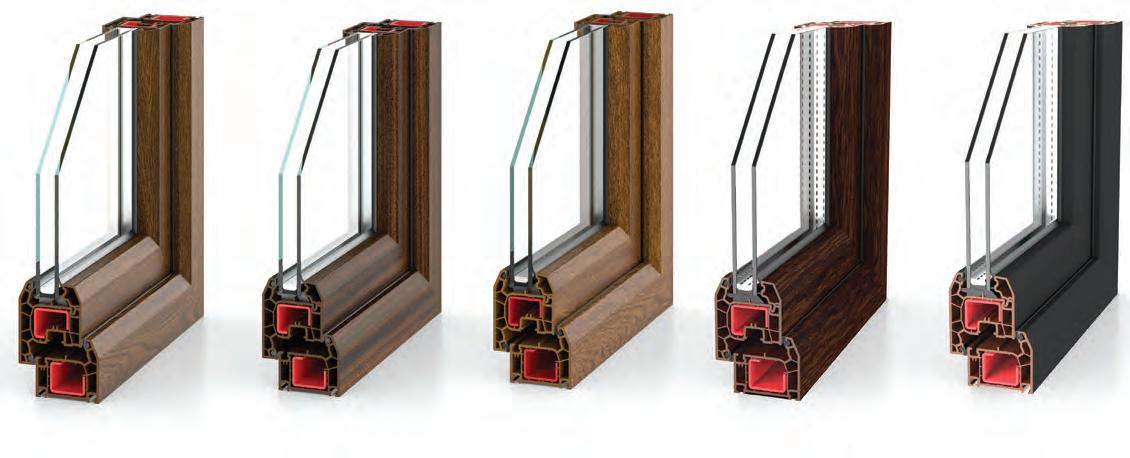
such as wood, aluminium or uPVC might change according to the preference of the customer, but the performance of the window, door or profile will all be the same. In a price and quality sensitive market like India, uPVC profiles will be the product that will bridge the gap between aluminium and wood hence it will take the major chunk of the fenestration industry in the near future.
What has been your or your organization’s contribution to bringing about the current revolution in the fenestration sector?
Being one of the leading PVC raw material consumers in the country, our betting on uPVC profiles is a testament to the current success and future growth of the product in the sector. We stand on the shoulders of giants who worked hard to get this product successful in our country.
As per your view, how can we assure the right selection of fenestration products and installation in a project?
Location of the site being installed, customer’s daily usage patterns and energy usage levels give us a clear idea of the type of products to
be used in the project. For instance, the use of high-performance glass will allow more natural light to enter inside while keeping UV and heat outside.
Do you think the decision-makers are aware of the availability of the various window and door products, their functionality & categories, standards, testing, etc? And how do they gauge the quality and functionality of the same?
Indian window and door industry have had a revolution in the past decade in terms of quality, performance and safety. Earlier
none of the decision-makers were aware of different available products. Over time they have caught up and are learning about the advantages of these products. But even now, there is a huge gap while selecting the window and door that is being installed. But as a profile supplier, we must make them understand the advantages and disadvantages of each product.
What is the emphasis laid on R&D, especially for the Indian fenestration market?
We are currently having a pipeline of products that will enhance the






performance of the window and the usability of the window for Indian conditions. An Indian customer’s needs cannot be compared to the needs of a European customer. The requirements of a city dweller are different from a person living in a town or a village. Our application development team makes sure they understand the needs of every customer and that we have a product for every need.
What do you see as the main challenges faced by the industry?
Lack of standards and lack of awareness of the quality of different products available in the market is the biggest threat that is being faced by the industry. In short term, a huge increase in PVC, aluminium and other product prices may cause the customer to select a lower quality material.
Tell us about your channel expansion strategies in the market.
We currently have a presence in the south, east, north and northeast markets. Shortly, we will be aggressively expanding to tier 2, tier 3 towns and pan India.

In long term, we want to create products that we can export to other countries.
What keeps your company ahead of its competitors in terms of services offered?
In today’s scenario, there is hefty competition amongst
the brand to stand out as the best. Even we are striving hard to service our customers in the best possible ways. We try to respond to every customer, and our team is not only involved in selling the product but sharing more of the product knowledge and educating the customer. We are a system provider for every customer needs. The ease of reaching us directly through different mediums has given us the advantage to be in touch with the product users.
How do you see the fenestration industry evolving over the next 5 years?
The fenestration industry is growing year-on-year and by 2026 we may expect a growth rate of an average of 15-20% every year. There have been many developments in past one decade in terms of design, quality, and use of materials. Even the pandemic has caused the market to slow down affecting the business growth. For sure, there is a brighter future for the industry and we may see many newer brands entering the market.


Imagine you perceive an elated experience from your workspace window with an immediate response to the Circadian Rhythm, amid your knottiest clock suddenly experiencing a swift rejuvenation in your thought process.
Surprisingly Yes, it is by the façade which acts you as cutting edge into the world to enjoy the environment created by nature around us or the microclimate created on-site by us.
Though the performance of the façade not only relies on the orientation of the building, according to the cosmos of the climatic zone but also on the selection of building materials of the envelope. So, designing the façade with higher Visual Light Transmittance (VLT) is advantageous. VLT levels increase from the ground and get reduced gradually towards the elevated levels.
Deliberate attention needs to be taken care of while designing the envelope of the Building. Sometimes increasing the VLT may also increase Solar Heat Gain Coefficient (SHGC). Façade having the reduced SHGC and higher VLT can bring us beneficial results in terms of both Visual and Thermal Comfort which in turn affects productivity, running cost & energy usage. In terms of Optimising Energy if SHGC is selected with a considerably lesser value then the burden on the Cooling Loads will
get reduced to a larger extent.
Proper Shading devices cut Glare, as Glare is one of the light pollution factors. The light shelf in the project helps us to cut glare and in the same way, provides us a Greater quality view. Glazing higher than 2.1m from the floor is called Daylight Glass which can have Visible Transmittance of 60% or higher and the Glazing located 2.1m lower from the floor is called Vision Glass which can have Visible Transmittance of 50% or more. We have another term called Window Wall Ratio (WWR), i.e proportion of the fenestration on the façade surface. Fenestrations with a 40% WWR is optimum for a better design to be adopted. In LEED we get 2 points by daylighting 75% & 3 points for 90% of the regularly
occupied spaces.
Case study: We were supposed to do the Sustainable analysis for a major renovation project and make the building more energy-efficient. Through our Building performance simulations, we found out that the project does not have proper shading for glazing resulting in much heat ingress and glare. We had introduced horizontal fins in strategic positions thereby solar insolation, the cooling load has been reduced and also the glare has been cut down.
During the Integrative process, Façade designing plays a major role in assisting the performance of the entire building by executing the preliminary studies on the implementation of the model to evaluate the performance of the

Office





proposed design when compared with contrasting façade typologies and scripts. The chance to have capable and corresponding effects during the distinct states of builtup of the design is righteous in executing the evidence-based selection during the determination of the process.
Building Integrated Photo Voltaic (BIPV) Panels serves a doubles purpose. It also acts as an outer layer for the building and similarly, it also yields electricity. Energy generated from BIPV can also be used on-site or can be exported to the grid. This technology is made up of silicon solar cells and also provides rescue in electricity and material cost. Incremental cost can be reduced when compared with normal PV systems as this eliminates the cost and also space issues for separate fixing systems. BIPV allows natural daylighting and solar-based thermal systems to gain control of the heat to generate electricity. Façade for the installation can be chosen by carrying out the Insolation Analysis, i.e. solar radiation received in kWh/ m2/day for the project, which helps in the selection of the façade which receives the maximum heat gain. Climate and weather conditions will also be a major influencers in installing BIPV. In LEED we can achieve up to 3 points for adopting
Renewable energy in the Project. Recycled Glass can also be used in façade thereby contributing to the Triple Bottom Line thereby enhancing the closed-loop circular economy material and also with an Environmental Product Declaration (EPD, in LEED we can achieve 1 point.
Façade's performance is efficiently measured not during its installation but only throughout its performance by regularly monitoring it. This is called Envelope Commissioning. It is a prime-based process for assessing the performance of adroitness of the envelope to check whether the project is meeting the fixed targets, standards, and necessities of the project. In LEED we get 2 points by adding the building envelope in the commissioning activities in alignment with ASHRAE. Envelope Commissioning can be performed not only for New Construction but also for Existing Buildings it can be pursued. Regarding the initial design and documentation, the project can be evaluated with the existing performance of the building. Thermal scanning, Air and water intrusion testing are adopted in the process.
Façade design encompasses Equilibrating Energy Optimisation, Thermal Comfort and Access to Quality Daylight seamlessly plays a significant role in building design thereby achieving 8 points in LEED. Proper selection of envelope materials contributes to the Project’s HVAC Load savings of 6.4% which in turn contributes to the Overall Savings of 2.6% in Project rescues.
At Conserve Consultants, We have “Design Performance Modelling” Services to provide the abovementioned analysis & Connect with us to explore more towards the next step on Sustainability.

AR.K.SARASWATHI
Principal Architect and Partner, Conserve Consultants
Saraswathi is the Principal Architect and Partner at Conserve Consultants with more than 11 years of experience in field of Sustainable Design, Sustainability and Green Certification for High Performance Buildings. She is a practicing Architect graduated from Hindustan College of Engineering. She is WELL, GRIHA & GEM certified professional and LEED Green Associate.
Saraswathi has managed multiple projects from design stage to the complete lifecycle of the development. She has successfully convinced many clients to implement cost effective energy saving measures, and ensured sustainable designs are implemented during the construction stage of the project.
The advent of globalisation has helped introduce new window and cladding systems, and cladding materials into the Indian market, which were not available earlier. This advent has introduced multiple choices to the designers and hence a designers need to carefully understand and select the systems that will suit the design best. The basis of design needs to be broadly done on the following parameters:
1. Climatic context: the choice of material for façade systems in context to local climate
2. Surrounding or micro context: the location of the building in context to its immediate surrounding
3. Design context: the choice of system, material and colour in the context of the intended design
Analysing these three contexts helps a designer choose the right material for the design being proposed. I’m elaborating these three contexts to give one a brief idea on what each context means in relation to design.
It is important to analyse the climatic context in which the project is being built. For example, in colder regions, more glazing area happens in the south while in tropical regions and Asian regions it happens more to the north. Many a time we just replicate a design
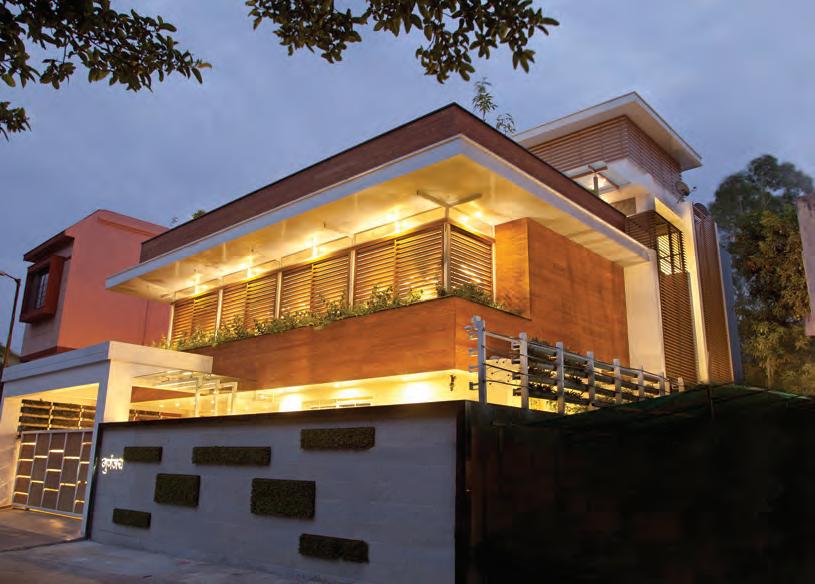
that we like visually as a reference, not realising whether it would suit that context. I have seen people use big glass panes along the south and east façades resulting in major heat gain into the structure. Even if the design intent has to be such, the choice of glass makes a lot of difference. From low lead content to low E glass helps in reducing the heat transmission through glass.
For cladding, I have seen people using normal wood which is not treated in heavy rain zones. Due to heavy rains, the wear and tear of the wood lead to high maintenance. Materials like Shera planks, destarched wood,
metal composite materials (MCM), Wood-plastic composites (WPC), High Pressure Laminates (HPL) are alternate choices one has to make in such geographical /climatic conditions.
When it comes to the choice of windows, I have seen many mistakes where a normal window section is put in a high rain or high wind pressure zone causing leakages and rattling of the sections. There are multiple choices one can choose from like ALU K has a high-velocity drain section designed frame so that water doesn’t flood the mainframe channel and also has a flap that


acts as a non-return valve, further helping to reduce flooding of the window during heavy rain and heavy wind pressure situations.
Many people choose UPVC windows in hot and arid climates not realising that plastic chips have a reduced life under high UV exposure leading to decolorisation and cracking of the section. Many clients opt for the cheapest solutions, not realising the quality

of plastic chips used to extrude the section. Some are cheap solutions that use plastics that are of not a certain grade leading to a lesser life cycle of the window.
Essentially this means climate plays a major role in the choice and selection of systems.
The next analysis one does is the context of the surrounding. For
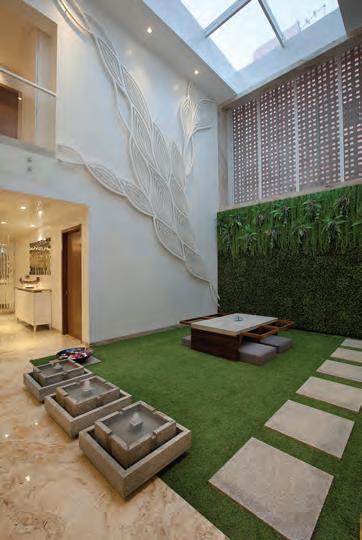
example, if the building is near the main road or is the room designed for high sound level - like a home theatre - making acoustical privacy concern in design. To reduce traffic noise and noise insulation from inside to outside, and vice versa, one can use triple laminated glass instead of double glazed systems. It is a common notion that double glaze reduces the noise but that is not so true or efficient. Double glass is meant more to reduce heat gain than acoustical insulation.
The position of the built form becomes a point of consideration if situated in shadow zones due to surrounding trees or structures. Areas that are in a shadow zone or covers by existing trees don’t need Double glazed glass for heat reduction but maybe a window on the east may require a double glazed system to avoid heat gain into the room.
security is also a very important concern while designing the window systems. In a high-end residence if the client wishes to avoid grills, which means one has to go for a more secured glass system. high-security risk zones like the windows on the ground floor or roof skylight canopies is

where one should opt for sentry laminated glass. If the cost of this is not within one’s budget, then concealing rolling shutters within the façade from the exterior side or within the curtain pelmet from interiors is a cost-effective option.
Invisible-looking wire or high tension ropes are more for safety from falling rather than security from outside intrusion. We also now have third-party technology that can be embedded into window systems that detect an

intrusion or if a window is left open by mistake and triggers an alarm on the client’s mobile device. The cost-effective alternative is to have glass break-in sensors installed and armed at night to detect any sort of intrusion. Locking systems are also a concern and in general, a multipoint or vertical locking system has a better life cycle and resistance to intrusion than a typical horizontal single locking point system.
The next analysis is the nature of the building. For example, in a residential building, the glazing would have vertical and horizontal fins to give a residential look rather than a simple glazed system where the subframes are hidden behind the glass which makes the built form look commercial in styling. While using glazing systems along a staircase block especially on the last mid-landing of the home, it becomes difficult at times to access the glazing panels and open them manually. In such cases, one can look at having motorised glass opening accentuates which motorise the opening of the glazed windows. These can also be programmed into a mobile device.
Choice of material is another analysis one needs to do. Depending upon the design intent of the façade, a designer chooses to clad certain walls in finishes like stone and wood.
Earlier natural stone was the only option designers would look at. From wet cladding of stones, the system graduated to dry cladding. Now from stone, the material choices have graduated to tiles and further on to slim tiles to reduce weight added to a structure. Besides this, you have products like MCM that replicate
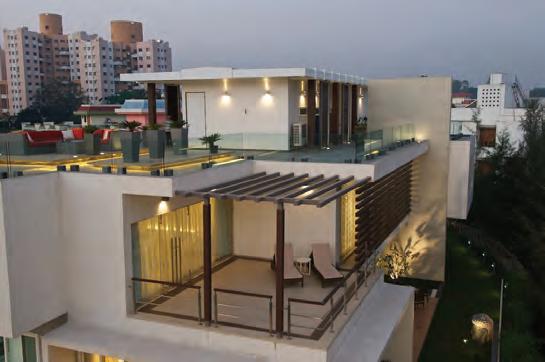

the feel of stone and wood at reasonable costs and which are much lighter and easier and faster to install. Wooden cladding earlier used to be expensive by using destarched wood. This difficulty was overcome with the advent of WPC or composite wood systems. Then came in ACP and HPL which looked like wood but didn’t give the natural feel. Things like wooden
cladding from MCM help replicate the same feel at a much cheaper cost.
In choosing windows, most designers today opt for a slimlooking section ensuring better visibility and a more seamless view with better sealing from exterior climate. Also, most designers opt for taller windows or larger widths of windows. This leads to a higher

In choosing windows, most designers today opt for a slim-looking section ensuring better visibility and a more seamless view with better sealing from exterior climate
weight of glass and may lead to difficulty in the opening if the right section and system are not chosen. Such heavy glass sizes and weights require sections with heavy stainless steel bearers which aid in the movement of a window. The next critical aspect of the design is protected from insects. Mosquito meshes inbuilt into a window system often remain visually obtrusive. Also, these meshes are flimsy and require a horizontal transform mullion to ensure the mesh doesn’t sag. The alternate solutions is vertical or horizontal retractable meshes that help to secure the occupants from insects and also have a better visual opening by not seeing the mesh all the time even when windows are closed.
The conclusion is that the choices one has are plenty in the market but making an informed decision based on this analysis of context makes the project better suited for the context and reason it’s built for. Getting carried away by fancy products is a trap most designers fall for not realising that at a later date the system doesn’t work, support, and solve the intent it was chosen for.
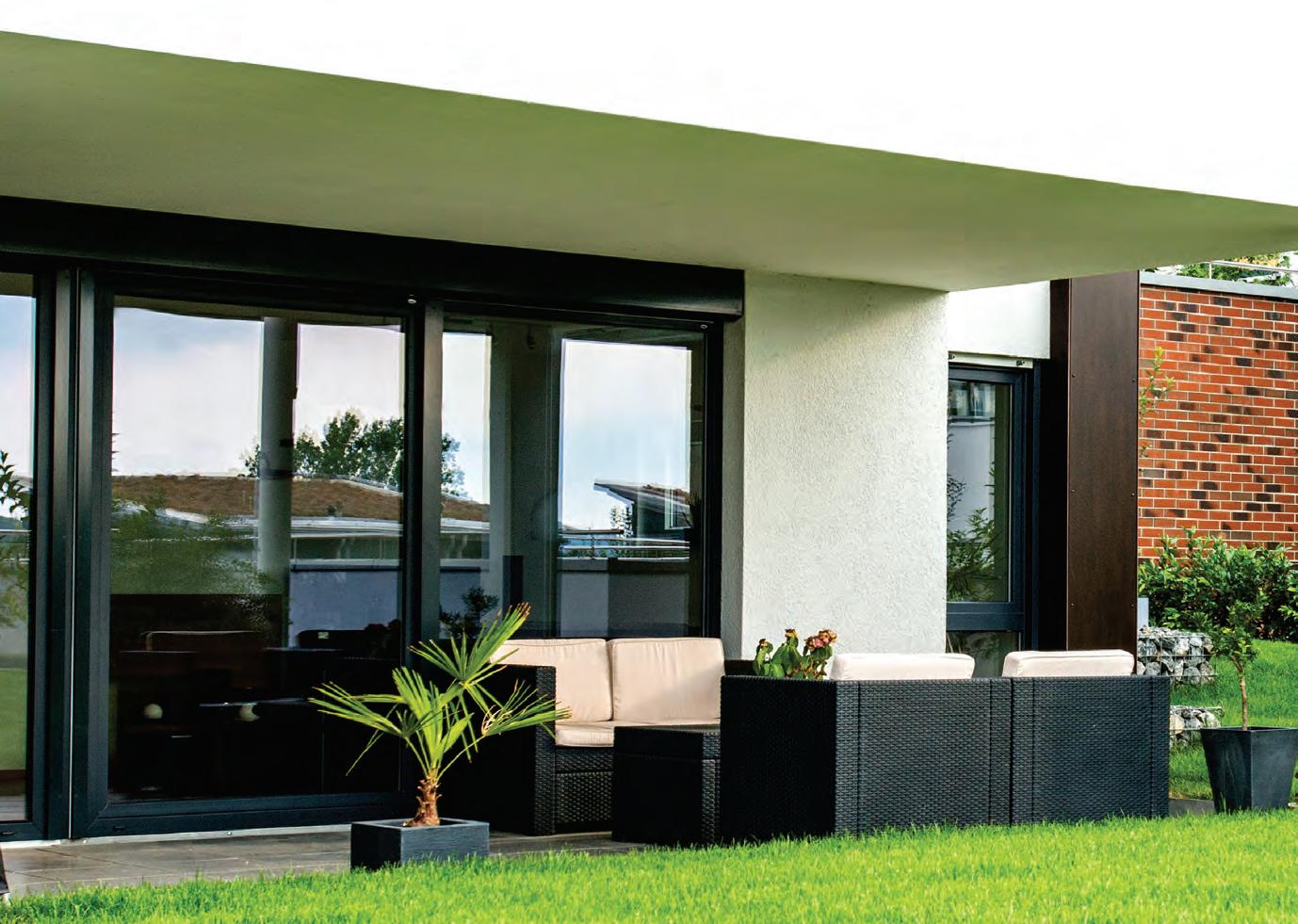
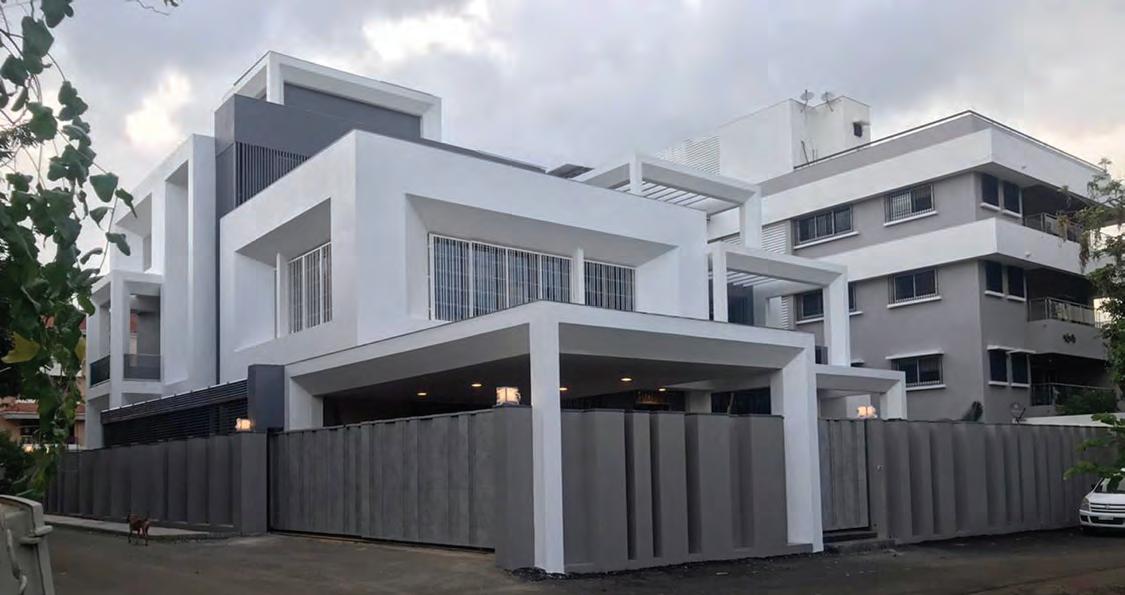
The Cubist Villa for a Maharashtrian joint family is situated in an urban context with an adjoining public garden. The client wanted maximum privacy from the road and massing to build upon the south edge as per vaastu. The form was derived out of skewed hexagonal boxes stacked one above the other to create visual appeal in the massing. The pergola formations on the northern edge were also created using these hexagonal geometric formations. A swimming pool in the setback space along the northern edge is screened by a pergola to have visual privacy. Major bedrooms face the public garden to visually borrow the landscape and the theatre, spa were kept on the north façade where the adjoining building is situated.
The souls residing in the villa get connected to nature with the large openings given by the architect, wherein the windows and sliding doors are nicely positioned with
a perfect equilibrium maintained for the nomenclature of the panel sizes given.
The system used is ALU K SC95 non-thermal break with highperformance glasses specifications as per the functionality and utility of the client, wherein for the hall and dining area the glass used is sentry laminated with softcoated ET135 from Saint-Gobain wherein the security concern was addressed with the glass and with multiple locking system provided in the sliding door.
The other areas like the home theatre are with acoustic laminated for sound resistance and for the gym the focus was to address the heat, so a double glass unit is used. However, to maintain the aesthetic, the shade of the glass is kept the same for the overall villa, and specifications with regards to DGU and sentry and acoustic were used as per the requirement and need.
GGS Designers and Fabricators Pvt. Ltd, a well-known aluminium
Project: Cubist Villa
Location: Nashik
Architect: Behzad Noshir Kharas, The BNK Group
Materials used for façade & fenestration: ALU K Windows / Exterior texture paint by Asian Paints
Commencement date: June 2018
Completion date: June2020
fabricator in north Maharashtra who has executed several villa projects in Nashik and Pan India, which has an excellent set up in Nashik with all German machinery has nicely fabricated the windows and installed the same.

This project Urban Oasis had a heavy functional requirement in proportion to the plot size. Also, the plot being linear meant that it was difficult for one to visualise the villa from all sides. The main road side traffic meant that the upperlevel living areas had to be pushed back by putting horizontal terraces and projections to create visual privacy. The lower level houses the office of the owner followed by the
Project: Project: Urban Oasis
Location: Nashik
Client: Mr. Surana
Architect: Behzad
Noshir Kharas, The BNK Group
Materials used for façade & fenestration: Calibrated Granite /MCM wood cladding/ALU K window
Commencement
Date & Completion
Date: June 2019, under construction

AR. BEHZAD KHARAS
semi-public areas like the living room, dining kitchen and guest room. The topmost level houses the family bedrooms and a lounge. This helps the private areas to get a clear uninterrupted view of the surrounding public garden. The existing trees on site were kept intact to bring in the landscape hence the need for using a reflective glass or high-performance glass was not a necessity. However, considering the aesthetic required and the safety concern, the glass used is brown tinted for the façade with PVB lamination, ensuring safety and to a considerable extent sound and heat resistance.
The fabricator from Nashik, M/S GGs Designers and Fabricators Pvt Ltd, has used ALU K System for all the sliding doors and windows with multiple locking. For the dining area, and home theatre, lift sliding doors have been used as the opening size is large, wherein each panel weight is around 370 Kgs.
The façade system used as an element feature for the doubleheight comprises of Aluminium RT of 150 X 50 as vertical members and 200 X 50 as horizontal members within which the fixed glazing is used wherein the system used has a proper drainage provision.
Chairman & Managing Director, The BNK Group
Behzad Kharas was a great highranking student of architecture winning numerous awards as a student. Graduating in 2002 from Rizvi College of Architecture, he worked with Architects Hafeez Contractor and Pronith Nath.
Ar. kharas started his practice from his hometown Nashik and then later shifted base in 2007 to Mumbai. The journey was never easy with too many failures and struggles, but that never led him to give up. Today he is considered as a peer to many, an influencer in the design industry and a man with strong ethos. With his vision and philosophy to be “humane, honest & humble”, he has led the group to where it is at present.

AR. DIKSHU C. KUKREJA Managing Principal, CP Kukreja Architects

Dikshu C. Kukreja received his B. Arch Honours as Gold Medalist from the School of Planning & Architecture. He attended the prestigious Taliesin Fellowship at Frank Lloyd Wright School of Architecture, USA and received his Masters of Architecture & Urban Design from Harvard University. He was elected the founding Vice President of Asia GSD, which grew to become one of the largest student organizations at Harvard University. He has worked in India, France and USA and has lectured and taught at institutions both in India and abroad. He has been a guest writer on Urban Issues for many
publications and featured by CNBC TV on the programme ‘Young Turks’. He was selected as Cultural Ambassador by Govt. of Finland. He is a Membe of Governing Body, Sushant School of Art & Architecture and was elected as the youngest President of the Harvard Club of India and the first architect to achieve this
distinction. One of his latest initiatives includes promoting awareness and sensitivity towards design through curation of a breakthrough design series, Deciphering Design with Dikshu, in collaboration with the media channel, NewsX. C.P. Kukreja
Architects (CPKA) is a premier multidisciplinary architectural and engineering organisation based in Delhi and is ranked amongst the top 100 architecture firms in the world and top 5 in Asia.

In an interview with WFM Media, Ar. Dikshu C. Kukreja elaborates on his vision, values, the firm’s landmark projects in India and abroad including the India Pavilion at the Dubai Expo 2020, and his views on future façade designs and materials.
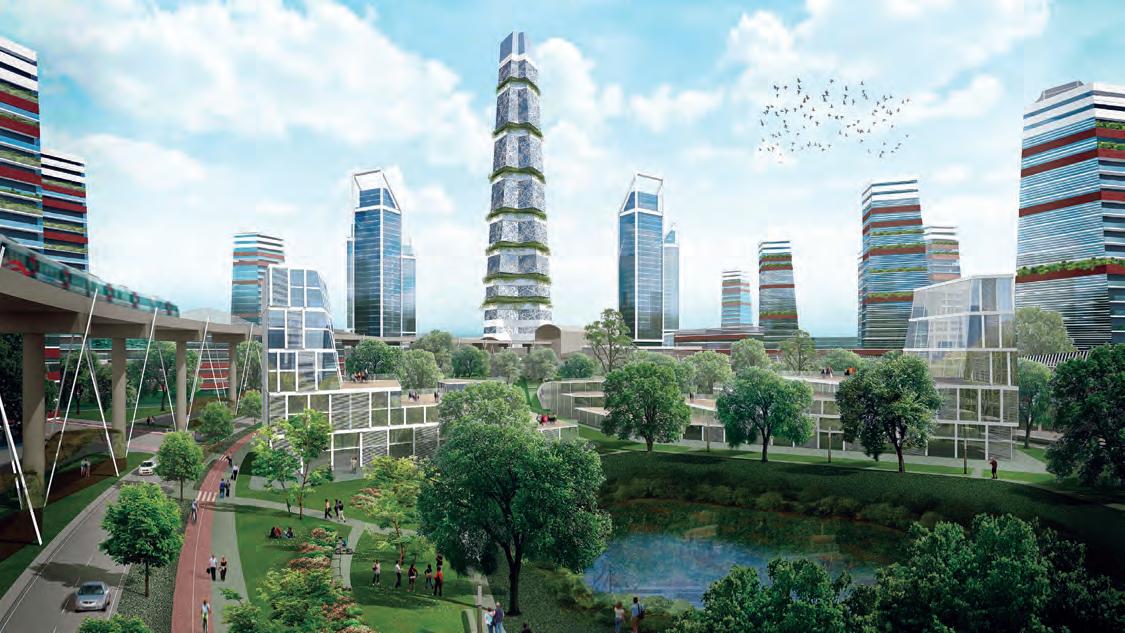
Tell us about your practice CPKA and its growth in India?
C P Kukreja’s vision, hard work, imagination and human values have been the core of our firm and have set the foundation for achieving what we have achieved today. Our team has been consistent in delivering meaningful architecture through significant projects over the last five decades which has not only made a difference in many Indian cities but abroad too. Concepts of ecofriendly design, culturally responsive architecture, and futuristic and innovative ideas have been propagated through the design and construction of numerous projects. Our practice has achieved many successful milestones from delivering the design of one of the largest to the tallest buildings in the country, promising that every project is special in its own way and gives out a significant message about the very idea of ‘architecture’ and its future to the society and beyond.
Over the years, what kind of changes are you seeing in Indian Architecture?
India has a remarkable history of sustainable, vernacular architecture
where buildings use passive design, local materials and respond to the site context. It is very difficult to define what “Indian Architecture” really is. To me, the future of Indian architecture is not about imbibing an identity that is only skin deep. It is about architecture that is sensitive to the needs of its context - social, political, economic and geographic. It is about creating a meaningful dialogue between the tangible and intangible aspects of the built form, and giving up superfluity, for a design that has a true impact on its surroundings.
What prompted you to become an architect and choose this as your career?
It has been a dream since as early as I can remember. The vivid memories of going with my parents particularly to monuments in and around Delhi for picnics used to always enthuse me. Though, at that time, I did not understand much, yet there was something that connected with me. I was instinctively drawn to buildings.
CPKA has designed many landmark projects around the world. Could you please tell us about your projects in India?
We are humbled to be associated with remarkable projects shaping our country at the moment. One of the highly anticipated projects is the India International Convention Centre at Dwarka, New Delhi which has been envisaged at the scale of a Central Business District (CBD). The state-of-the-art Convention Centre would be Asia’s 2nd largest and the 3rd largest in the world with a capacity to host 10,000 people at once, designed to host mega international events in India like the G20 Summit. With a site area of 225 acres, the project also boasts of a 20,000 seater one-ofits-kind, world-class indoor arena with a retractable roof that would be built in India for the first time.
Another project which has our team excited is the East Delhi Hub, conceived as the pilot project for Transit-Oriented Development (TOD) in India, being developed at Karkardooma, New Delhi along with the tallest 100-storeyed tower in the country. The use of ‘organic density’ as a tool for spontaneous adaptation to environmental and economic diversity, and as an autoadjustable controlling measure for the population influx and activities within the urban complex, lies at the crux of this revolutionary vision.
Any building is identified by its façade, hence the clients too are ambitious. There are many kinds of innovative façade materials available in the market, including for cladding/glazing. How do you go about selecting façade material?
Façade of a building provides the most apparent visual experience that a user or visitor can have of it. Innovation is creating new kinds of façade materials with changing times. There is, in fact, a greater variety today more than one has seen ever before in terms of what architects can incorporate in the facades of their buildings. In terms of selection, our process is a result of multiple factors since façade is one of the most important aspects defining the relationship of the visuals of the building with the viewer. So, the façade selection is based on parameters such as the contextual representation of what the design portrays, choice of availability of local materials,

fabrication or manufacturing or modularity of its usage, the persona or character that the façade material needs to demonstrate and lastly the cost of the material with respect to the overall budget allocated to the project.

Please tell us about your projects abroad?
We recently completed the India Pavilion at the World Expo 2020 Dubai. We are also the architects for HCL’s Vietnam office where


The Expo 2020 Dubai is a global stage for renowned architects from all over the world to represent countries whilst showcasing design finesse. With an overarching theme of ‘Connecting Minds, Creating the Future’, it is a platform promoting partnerships for innovation, inclusion and understanding.
The design for the India Pavilion seeks to

become a blank canvas given to India to tell its story. Weaving technology and craftsmanship together, we were able to bring forth a concept which befittingly capsules the diverse cultures of our country whilst captivating the visitors through enthralling storytelling.
Through the Pavilion, we hope to celebrate the cultural multifariousness of our country whilst nurturing the idea of India as a pool of opportunities for investment and collaboration. As one of the fastest-growing nations in the world, the design of the Pavilion imbibes the theme of ‘India on the move’. The façade comprises 600 individual blocks that move using kinetic architecture. The design also celebrates India’s 75 years of Independence. Through seventy-five identified stories, the façade would engage visitors through the charm of storytelling through the day – familiarising them with the history, geography and literature of the country. In the evening, the façade will turn into a vibrant show with sound, light and projections, almost as if hosting a festival. The pavilion is the tallest at the Expo. We used

exhibit the substantial growth the country has witnessed through the years after independence, becoming a land of limitless opportunities even for international investors.
For us, representing India on an international platform at Expo 2020 Dubai meant developing a design for the India Pavilion that creates a meaningful dialogue between the tangible and intangible aspects of the built form. This was a very unique project to work on because it is showcased on a global stage where you have an assortment of architecture from around the world. We felt that the best way to communicate an India on the move, the transformational aspects of the country so to speak, was to bring that dynamism to the façade. We chose to represent this using a kinetic façade with rotating elements that can


Through the Pavilion façade, the cultural multifariousness of our country is celebrated
sustainability as one of the key design features, integrating climatological influences of the region with technology. Movement in the façade helps control factors such as sunlight and wind inside the pavilion which is helpful in regulation of natural daylight and ventilation.









the design is conceptualised using biophilic design. The design concept blends innovation in a modern workspace with refined aesthetics and high-end technology that enhances the functionality of space, inspires its users and initiates a reimagined office model.
Tell us about some innovative technologies and materials that you have used on facades?
Through our designs, the aim is to lead architecture as an amalgamation of creativity and engineering. The building envelopes in India International Convention Centre, Dwarka, New Delhi, are designed to communicate an image of contemporaneity inspired by tradition. A thoughtful skin system is proposed to achieve sustainability, as well as synthesise each facet of the project, such as materiality, constructability and budget. It is mainly focused on performance and constructive
optimisation. All façades are proposed to be layered in two orders. The first one will be a regular system, attending to all static conditions and the other is the structural system, which will be optimised to be integrated into the building structure. One of the most talked-about design features include the crowning of the Convention Centre with, what is poised to be the world’s largest, LED video wall. The video wall is specially engineered for the project. LEDs will be accessible from behind, and grating catwalks would be provided for ease of maintenance.
Façade of the Gomti Nagar Railway Station Redevelopment is a bespoke amalgamation of the grandness of Awadhi architecture. The jaali adorning the face of the complex spans the entire length, punctuated by a pattern which seems timeless in appearance. It is complemented by the introduction of arches in the skin while accommodating it as the
structural element to the outer face of the terminal. Taking inspiration from the traditional domes, the roofs take a curvilinear shape, also lining photovoltaic cells upon it.
The glass and glazing industry has gone through a major change over the past 15 years. What are your observations?
The glas\s and glazing industry has undergone a tremendous metamorphosis over the last decade and a half. From simply being a material that was looked at for consistency in quality, today is incorporating various techniques and technologies pertaining to its sustainability factors. Technologies that support environmental design, allow the envelope to be far better controlled and also assess the constructability have transformed the material from its initial stage. The glazing industry is also incorporating factors such as daylight control in its mechanism which empowers the buildings to be climatologically responsive.



With digital projections and 3D mapping, the façade can communicate with its visitors. Additional features such as selfcleansing glass, etc. are useful for promoting innovation. The future that I see for the industry is that it incorporates as much technology as well as drive forward with sustainability.
Convincing a client regarding certain design features is not an easy task. How do you go about it?
Not getting classified into a single silo of a certain kind of building or a certain kind of client, we believe, that architecture cannot be restrictive in that sense and that we should be able to deal with all situations, all projects, all sites and all kinds of clients. Accordingly, we have consistently worked, both, in the private sector and on Government projects. Both kinds of situations bring their challenges and their pros and cons.
My personal experience has

been that a client is willing to listen, provided we have the conviction and ability to be able to convey to them, our design ideas and thoughts. Once that is done, I think the experience can turn out to be very positive.
What're your views on the future facades?
India seems to be witnessing exciting times with the plethora of opportunities waiting to be explored in its design and development sectors. The availability of large development areas like new cities, towns, etc. makes the scope for growth through green practices an achievable feat. The way forward is to definitely integrate technology with design – making facades kinetic so they can respond to their surroundings will amplify the sustainability factor of a building.
Additionally, this also is the perfect time to be learning through the design and development practices already implemented across the world and customising and formulating them to suit the country’s requirements for us to benefit best out of them. The public today is deeply engaged with topics that concern the overall urban development, influence of design on the mental wellbeing of the citizens.
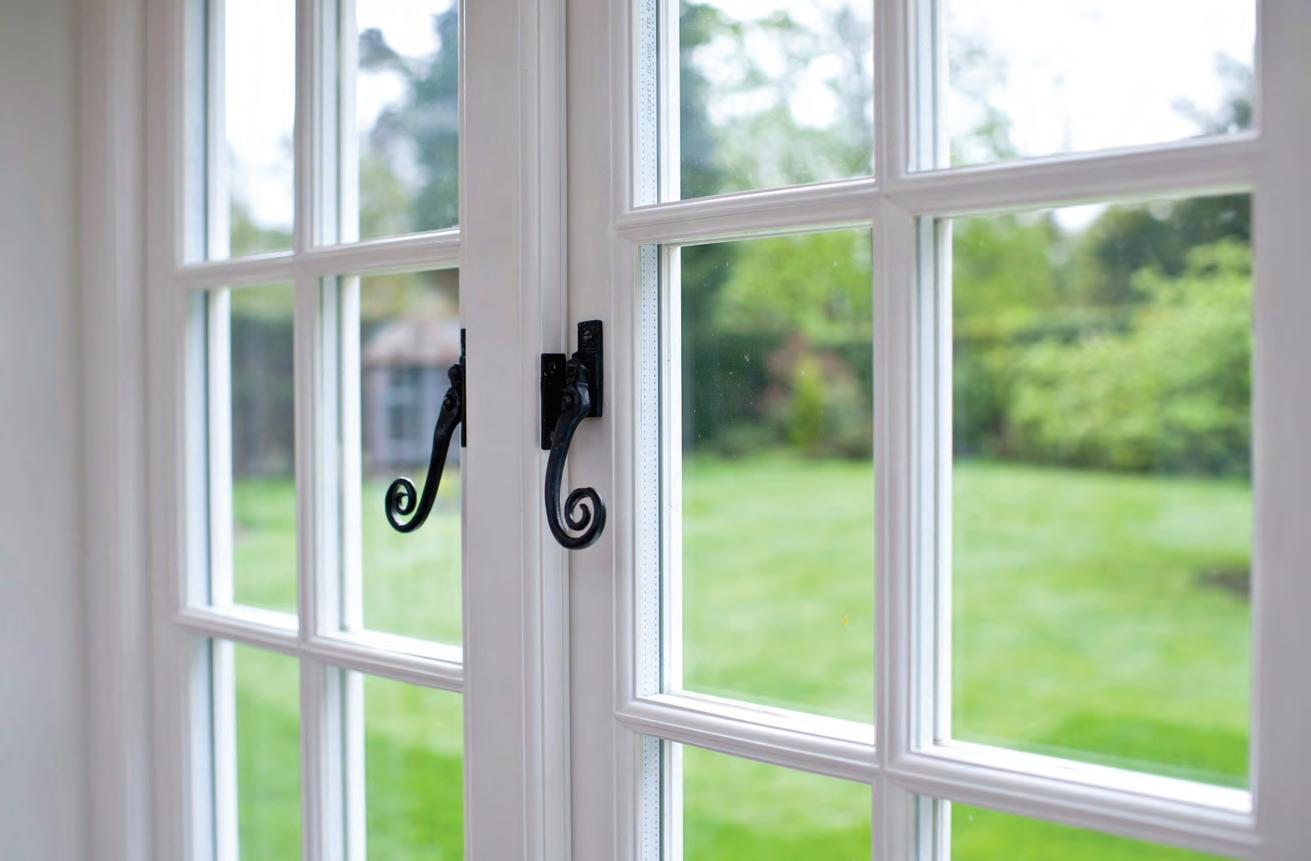




Sun Estates builds luxury homes in pristine locations in Goa. Sohonos is built in Nerul, Goa amidst beautiful backwaters. The location ensures privacy, access to nature, lush surroundings and yet an easy breeze to walk to the beach. Sohonos is designed by New Yorkbased architect David Ruff who has designed some of the most premium villas worldwide.
Every property built by Sun Estates places importance on the façade and fenestration design. The façade is the “first impression” of a property and also has the power of “recognition”, of finally making us feel at home. Fenestration and façade design plays a very important role as they define the scale, aesthetics and the architectural language of the project. Beyond the functional and aesthetic aspects, fenestration also has other impacts on the people using the spaces. Light, shadows, ventilation
play an important part in creating positive moods in people using the spaces. Fenestration trends have moved towards new materials and energy-saving technologies.
Some of the new trends include screens and louvers, large glazings, etc. Fenestration can significantly impact energy savings with the use of double glazings, correct design and orientation, screens to cut the direct sunlight, etc. Reducing heat gain is one of the primary areas for energy savings.
At Sun Estates, great emphasis is placed on designing the doors and windows as they are the connections of the interior with the exteriors. All designs are based on the merging and flow of spaces from interior to exteriors.
The façade at Sohonos has a contemporary design with clean lines balanced with the use of metal louvers giving an interesting pattern to the façade. The main design element is the layering of the glazing with façade louver elements towards the mesmerising view. The grand glazing creates an element of space, closeness to


the surrounding lush backdrop of nature and ensures natural light throughout the day. The glazings are seen as transparent walls which run the whole width and height of these rooms. The height of these glazings are nearly 10 feet and give a grand feel to the spaces. The aluminium sliding system uses heavy-duty sections with stiffeners due to wind loads. For ease of use, the tilt and slide system has been made use of.
. The façade is more closed towards internal roads and more open with large glazings towards the view and the pool. This design of the façade ensures a feeling of positivity as sunlight flows into the area while ensuring the most premium view.
The kidney-shaped skylight is double glazed to ensure a more sustainable design. Double glazing improves ventilation and during summertime and preserves heat during winter months. It acts as a moderator inside the villa and ensures that the climate is more friendly. Double glazed windows reduce carbon emissions upto 680 kgs per year. In addition to the double glazing, façade louvers and screens are used to cut direct sunlight which can be prominent during summers in Goa. It thereby reduces heat inside the villa while still ensuring good visibility outdoors. The tilt and slide system helps to increase ventilation and save energy. It also seamlessly
Project: Sohonos
Location: Nerul, Goa
Client: Sun Estates Goa
Architect: David Ruff from New York
Materials used for façade & fenestration: (window/door/façade materials): MS elements, painted plastered surfaces
Commencement date & Completion date: 20162019

SURAJ MORAJKAR Managing Director, Sun Estates Developers
ABOUT THE AUTHOR:
connects the indoor environment to the outdoor environment while offering promising views upwards towards the skylight.
The materials used in fenestration includes painted plastered surfaces and MS elements. premium quality of materials are used for the façade and fenestration of luxury villas.
As new-age consumers are getting more conscious about sustainability and the environment, it is important to include environmentally friendly options in design. It is also the most socially responsible decision for any builder or architect.
Suraj Morajkar and his successful legacy chain of luxurious homes and hotels is symbolic of his passion for creating something everlasting and blissful. His sense of architecture and his eye for detail are what make his properties so aesthetic and modern. He belongs to a generation which saw big career opportunities within Goa itself, bringing names like Tarun Tehliani to his place of heritage and collaborating to create something larger than life. Morjakar started by exploring everything that Goa had to offer while ensuring that his pieces of architecture had a local connection and style presenting a local-luxury mix that none of the others could offer. He turned Goa into a luxury powerhouse with world recognition, which made the people of Goa proud of his work and gave him the status and recognition he deserves.

The Wienerberger Group, a leading international provider of smart solutions for the entire building envelope and for infrastructure, announced f the 50 nominees selected for the Brick Award 22. Wienerberger is one of the world’s largest producers of bricks (Porotherm, Terca) and is a market leader in clay roof tiles (Koramic, Tondach) in Europe as well as concrete pavers
(Semmelrock) in Eastern Europe.
A company release says that a record number of 789 projects from 53 countries has been submitted to the Brick Award 22. The 10th Brick Award has had the highest number of entries in its history, demonstrating the internationality of this architecture prize. Five categories are assigned to the Brick Award, within each of them a category price will be awarded, next to the overall winner. The winning projects in those five categories “Feeling at home”, “Living together”, “Sharing public spaces”, “Working together” and “Building outside the box” as well as the overall winner of the Award will

be announced at the official Brick Award ceremony in Vienna, June 2022.
l Announcement of the 50 nominees selected for the Brick Award 22
l Record number of nearly 800 projects submitted
l Winners to be announced in June 2022
Category: Residential
Type: New Construction, Public & Commercial Building, Hotel Style: Visionary
Architect: Zero Energy Design Lab, New Dehli
Photographer: Ande Fanthome
Completion Date 2020-12-31
Category: Residential
Type: New Construction, Single-Family Style: Mediterranean
Architect: Wallmakers, Kerala
Photographer: Jino Sam
Completion Date: 2020-12-31

Girl's hostel block, st. Andrews institute of technology and management, india designed by zero energy design lab, new dehli
For the Brick Award 22 the jury observed a strong European focus, 34 of the 50 shortlisted projects having been submitted by European architects, 12 coming from Asian bureaus and 4 Latin American nominations.
“The development of recent years continues, the focus remains on resource-efficient construction. This concerns both highly innovative structures as well as those built in the traditional way with local materials and craft techniques. Re-use is just as present as the imaginative use of bricks. This almost playful approach leads to concise, memorable designs. The weighting of the different categories is almost balanced, showing that brick is represented in all building typological areas.” explains Heimo Scheuch, CEO of Wienerberger AG. All 50 nominees can already be found on the Brick Award website: https://www.brickaward.com/
Saint-Gobain, the design solutions company, has acquired a minority stake in Livspace. With this acquisition, Saint-Gobain is focusing on the rapidly growing residential markets in India and South-East Asia. Livspace is a digital-first intermediation platform that offers end-to-end solutions for home interiors, design and installation. This investment aims to complement SaintGobain’s full range of solutions in India, which accounts for over 80 per cent of the country’s building construction market, the company said in a statement. This investment cements a strong
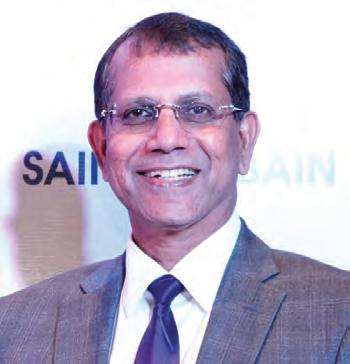
MR. B. SANTHANAM CEO Asia-Pacific, Saint-Gobain.
strategic partnership between the two companies. This is a major step forward in "Making the World a Better Home."
It is yet another major milestone for saintgobain Myhome in its journey to provide end-to-end, sustainable, and innovative solutions to homeowners and designers in India. “I am very pleased to partner with Livspace. Over the last two years, our businesses have focused on developing an innovative approach for the home segment by offering its customers end-to-end solutions (design to installation),” said B. Santhanam, CEO Asia-Pacific, Saint-Gobain.
NCL Buildtek presents a wide range of best-in-class building materials.
Starting from AAC blocks that are used at the preliminary stages of a building to putties, paints, tile adhesives, windows and doors, the materials are made to the best standards. Developed in collaboration with international partners, the company offers an uncompromising commitment to quality which has made NCL Buildtek and its products the preferred brand of choice amongst independent home owners, architects and builders for over 40 years.
In the windows segment, ALUMINIUM is the ultimate symbol of class and beauty. “ALLURO” series from the house of NCL is the new IN thing for the windows market. The elegant, sleek and alluringly beautiful

MR. BH. SUBBARAJU Managing Director NCL BUILDTEK LTD
designs from the ALLURO range offer exceptional functionality as well as aesthetic appeal. Backed by an experienced and dedicated team of service professionals, NCL’s Alluro series is uniquely positioned to bring international-class windows to projects of all scale and are all set to change the future of the windows segment in India.
For more details contact:

NCL Buildtek Ltd., NCL Pearl, 5th Floor, 10-3-162, SD Road, Opposite Hyderabad Bhavan, East Nehru Nagar, Secunderabad, Telangana-501504.

aluplast’s new experience centre at Saket, New Delhi
Aluplast India launched its newest experience center in the heart of the Indian Capital City of Delhi. Bringing the finest German window technology to your doorstep, the experience center showcases the latest innovations in the fenestration industry. The aluplast group ranks amongst the world’s top brands in its business of developing, producing and distributing innovative uPVC window systems.
Aluplast has become a key global
player in fenestration Industry. It is a family-owned venture that has grown to become one of the most successful companies in the field of uPVC doors and windows.
Aluplast is well known for its state-of-the-art and contemporary uPVC systems for doors and windows. The range of systems includes Smart-Slide, Lift-Slide, Tilt and Turn, French Window, Corner Window, Sliding Systems, Louver Door, Fold and Slide Door and Casement Door, to name a few. aluplast boasts of the highest level

of customer satisfaction with its superior quality of systems that are so easy to operate.
One of its new products, aludec, the next generation window surface is the perfect combination of all the benefits of uPVC windows while giving the look and feel of a aluminium surfaces on window, and is a perfect solution for both indoors and outdoors.
Durability and longer lifespan, easy installation, cost effectiveness, and easy and low maintenance are some of the features that are synonymous with our uPVC systems. Most of the systems are available in trendy colours that fit beautifully in the surrounding.
For more information visit –www.aluplast.net/in or write at marketing.in@aluplast.net
aluplast India Pvt. Ltd.
Unit no. 29 & 30, Ground Floor ABW Rectangle One, D-4 Saket Block M, New Delhi - 110017 Toll-Free: 1800 233 4777








Ozone, a leading manufacturers of Architectural hardware with high-quality products, will set up the new Industrial Cluster in the Ghiloth Industrial region in Rajasthan to cater to the domestic & international market demand via the government’s ‘Make in India’ initiative, and thus the company will increase its manufacturing capacity. The company, planning to cater to the rising global demand, will have the facility laid out in 13 Acres, with a world-class research and development centre. Ozone manufactures specialised digital door locks, glass fittings, automatic doors, electronic safes, demountable partition systems, and framed shower sliding systems, etc.
While the company has aligned its production capacity as per the requirements of the ‘Make in India’ campaign, its vision is to ‘Make for the World’ to cater to global demand and serve across 40 countries. The company’s portfolio has over 5000 products.

Mr. Alok Aggarwal, Managing Director, Ozone Group
Currently, it has four manufacturing units located at KalaAmb, Himachal Pradesh for manufacturing digital safes, railings and glass fittings. The facilities boast state-of-the-art technology imported from the best brands around the world.
Commenting on the launch of the Ghiloth facility, Mr. Alok Aggarwal, Managing Director,

Ozone Group said: “Ozone is a trusted name when it comes to architectural hardware and security solutions. We have a long-standing tradition of delivering quality products that match international standards and norms. With a rapid rise in urbanisation and commercial activities worldwide, the demand for these solutions in recent years has grown multi-fold. And it is an opportune time for Ozone to contribute to the country’s ‘Make in India’ campaign. This facility will add to our growth and help us in meeting the growth plans.”
Recently, the company has launched a range of digital door locks. It has been aggressively marketing the range of digital locks with its Guchcha Singh Campaign through Above-The-Line (ATL) marketing.
From the Ghiloth facility, the company will be manufacturing furniture hardware, door hardware and other architectural products. The facility will have R&D center and certified testing lab. The company also said that it had assigned a CAPEX outlay of approximately 200 CR. for the next three years.
For more details

OZONE GROUP call or WhatsApp: +91-9310012300 or E-mail at customercare@ozone-india.com Visit website at www.ozone-india.com to explore the hardware range




25 South is a residential project located in the upscale neighborhood in South Mumbai / Prabhadevi with breath-taking views and tranquillity of the bay. 25 South is a bespoke seafront residence and is one of the largest acreages next to the Arabian sea. This building is designed to reduce the boundaries between the ocean and everyday life.
It is designed by Ar. Hafeez Contractor/Ar. Karl Wadia Design (Senior Associate, AHC) where the sky, sand, and the sea welcomes everyone to the isle of calm. 25 South offers luxury and boasts about its maximum open spaces, flexible residence design, and panoramic view of the city.
Alumil has used 4 different systems in this project. In the living room area which has a sundeck outside, Alumil has supplied a minimal system in which the glass


Project: 25 South
Location: South Mumbai (Prabhadevi)
Client: Hubtown Developer
Architect Firm: Architect Hafeez Contractor
Lead Architect: Ar. Karl Wadia
Material used for façade fenestration: Alumil Systems
Other Consultant: Landamm Façade (Israel) Fabrication Team: Innovators Façade Façade Audit: Axis Façade
shutter gets concealed into the frame from all four sides and the interlocking section is only 32mm. With the help of this, you have more glass vision and very minimal visible aluminum sections.
For the bedroom, a bespoke 2 track 2 shutter is a product specially designed for this project wherein you have an integrated railing in a full-height window of which all the glass panes can be cleaned from inside of the house. It also has a very specially designed water drainage

system to stand against heavy rainfall in Mumbai.
The innovative tilt and turn window with controlled airflow for cross ventilation brings in maximum light with minimum heat.
The casement windows are with 3 layers of EPDM sealing for better insulation of sound, water, and air also. Wherever it was required, the lock and key mechanisms have been provided in the window.
The bathroom curtain wall is a special element in the overall aesthetical view of the building wherein Alumil has provided a 200 mm bullnose fin that runs through the overall length of the building with augments the charm of the tower.
At ALUMIL we are building excellence every day. Through our modern production facilities and strict quality controls along the entire production line, we ensure the creation of superior products of high added value. Our continuous research and development lead to offering unique solutions with many innovative features, which totally meet the needs of our customers.
For more details, contact: Alumil Systems India Pvt Ltd, Office No. 901-902, Plot No. 9, The Affairs, Palm Beach Road, Sector 17, Sanpada, Navi Mumbai- 400705 Tel.: +91 8655045595, Website : www.alumil.com/india E-mail.: info.asi@alumil.com
Klimas Wkręt-met is 30+ years old and is among the largest fastener manufacturers in east and central Europe. Tell us about the brand’s entry into the Indian market and the major achievements since then?
l KLIMAS Poland set up their first office in Asia in February 2020 along with a warehouse facility. Indian market is very vast and there is huge potential for façades and fenestration sector - be it curtain wall glazing, aluminium/uPVC/wood/ steel windows and doors, fire doors, railings, louvres, fins, GRC panels etc. There is a great opportunity and we have solutions for various base materials.
l Since the last 18 months, KLIMAS products have been supplied to more than 850 customers across India for various trades and we had been part of several iconic projects in varied segments already in the first year. We are
associated with top OEM brands in windows, railings, doors, ventilated facades, GRC, etc. and are supplying them with our fasteners regularly.
Kindly brief us on your products and services offered in India?
We supply the following categories of products:
1. Polyamide frame anchors for installation of uPVC, aluminium, steel, wood windows, and doors.
2. Polyamide frame anchors for installation of GRC facades, stone dry cladding, ventilated facades, ACP cladding.
3. Metal wedge anchors for curtain wall glazing, unitized /semi unitized facades /dry cladding/ ACP cladding.
4. High-quality screws for uPVC window and door production
5. Polyamide anchors & metal and chemical anchors for glass railings, balustrades, etc.
6. Polyamide and metal wedge anchors for louvres, fins, etc.

SUNIL GURTOO Managing Director, Klimas Asia Region
Our services include:
l Technical support in terms of design calculations for anchor selection
l On-site demos and training to increase the know-how among the users
l Factory training in terms of

correct usage of KLIMAS screws
l On-site anchor pullout testing across India
l With our main warehouse in Mumbai and nine warehouses in India, we ensure on-time delivery of KLIMAS products.
Tell us about your manufacturing facilities, distribution systems and future expansion plans?
KLIMAS’s headquarter is in Poland with four manufacturing plants. The total covered area is 80,000 sq m with high-tech modern machines which makes KILMAS one of the largest fastener producers in Europe.
We supply globally to more than 65 countries and mainly through
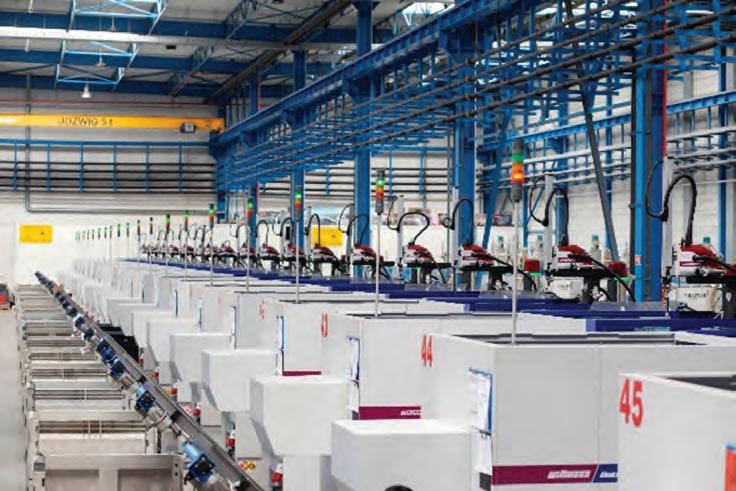

our exclusive partners. In India, we are the first company to have Display Centers across major 10 cities with warehouses through our exclusive partners to ensure on-time deliveries.
In 2022, we plan to extend our network to another six states of India. We are also targeting to reach Tier-II and Tier -III cities through a network of dealers under our exclusive partners to ensure the KLIMAS brand reaches users in these cities, towns, etc.
In the next 5 years, our aim is to be reckoned as the best fastener solution providers for the fenestration industry across India and also for other application areas too as our range is vast.
How do you ensure customer satisfaction and long-time relations?
l We believe in offering the best for our customers to value their money - with the most optimised solutions for their applications.
l Ensure on-time deliveries through our exclusive partners

with stocks available across major cities in India, this helps in reducing extra courier or air freight costs.
l Fair pricing is very important; the aim is to offer fair pricing to all fenestration segments thereby adding value to their product and systems, system as we believe if the pricing is right every fabricator will opt for a good quality product, thereby avoiding the cheap quality products available.
l ontime technical support is important, and we are committed to ensuring technical support is provided within 24 hours.
Pull-out Anchor Testing is a very important aspect, and the company has invested in 15 testing machines to ensure ontime service.
Sunil Gurtoo, Managing Director (KLIMAS Asia) Klimas Fastener Technologies
Gulshan Building, Office No.- 3, Baner- Aundh Rd, Baner, Pune, Maharashtra- 411045
Contact no.- 9823080265, Email- s.gurtoo@klimas.com
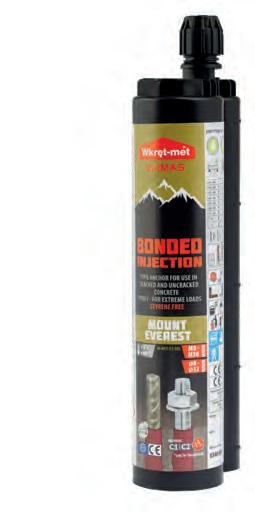













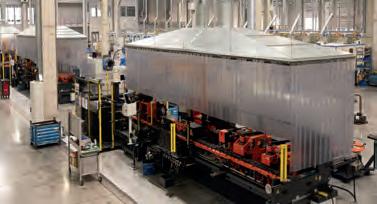













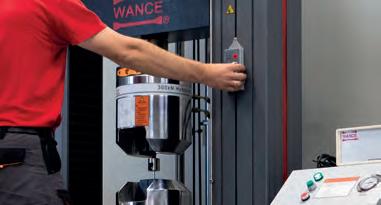
The two products - barrierfree threshold ECO PASS SKY and ECO PASS SKY PLUS from SIEGENIA - take the current trend towards large glass surfaces with their high light incidence into account and offer optimum transparency and room comfort. They are designed for liftslide elements made of timber and timber aluminium. These designs permit fixed sash glazing directly up the threshold (SKY) and even into the threshold (SKY PLUS). This makes large surface elements a real eye-catcher.
The superior appearance is supplemented by further aspects of room comfort, e.g. the unlimited barrier-freedom with unobstructed access to the outside. The height of the two thresholds is only 5 mm. The product is highly energy-efficient - thanks to the high glass content of the ECO PASS SKY solutions. A pleasant indoor air climate and a high degree of comfort are thus always ensured.
Homeowners with high-security demands can also use the two thresholds in connection with the AEROCONTROL opening and locking monitoring system:

The new ECO PASS SKY and ECO PASS SKY PLUS thresholds make large surface elements a real eyecatcher
This reliably reports the relevant opening or locking status of the element via a magnetic switch in the lift-slide door for a wide range of opening schemes. Integration of alarm systems is also possible. According to the switch type, this solution fulfils the requirements of up to VdS Class C.

DRIVE axxent HSA
smart: 400 kg at the touch of a button
The optional DRIVE axxent HSA smart concealed drive ensures ease of use. It operates sash weights up to 400 kg at the touch of

The DRIVE axxent HSA smart concealed drive ensures pure ease of use. Its elegant aesthetic is underlined by the flat stainless steel control knob
a button and combines the convenient motorised operation with aesthetics, indoor air quality and barrier freedom. In terms of design, the DRIVE axxent HSA smart impresses with its concealed lift drive. It gives the element an appealing, elegant aesthetic that is also supported by its flat stainless steel control knob. Its surface-mounted slide drive is discreet and elegant too, which is perfectly integrated because it can match the element's colour. The sash can be opened or locked either via this stainless steel button or conveniently via your own smartphone or tablet with the standard SIEGENIA Comfort App. An optional infrared remote control is also available.
For more detail contact: SIEGENIA India Pvt. Ltd. Plot no. 52, Sector 37, Udyog Vihar Phase VI, Gurugram 122001, Haryana, India. Phone.: +91- 9971177168
Email: info-in@siegenia.com

















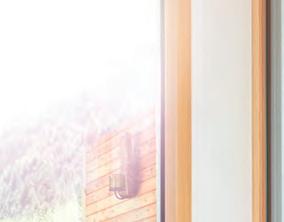



























Kingston Multi Products India (P) Ltd is a New Delhi-based business organisation established in 2010, with a vision of providing qualitative economic range solutions to various industry segments related to construction, automotive, interiors, uPVC, etc.
Brand Kingston and Insta is a part of IK Group comprising two ventures - Glorious products (India) Pvt Ltd (INSTA) and Kingston Multi Products (India) Pvt Ltd, having a diversified range of building hardware and construction products.
In 2010, Kingston introduced a fast & easy false ceiling installation solution to the market in acoustical false ceilings, tee-grid sections, acoustic wall panels and then expanded to many types of sealants and adhesives supporting various industries for Glass, hardware, automotive, uPVC, Solar, decor building, etc.
Kingston Sealants commits to providing the best solutions for sealing, bonding, caulking, and



DHEERAJ GUPTA
Director - Sales, Kingston Multi Products India (P) Ltd
insulating by supplying spray polyurethane foam, silicone sealant, acrylic paintable sealant, polyurethane sealant and construction adhesive and so on.
Kingston is a well-known brand in India and neighbouring countries. They gradually developed products that were suitable for Indian industry as well as for our neighbouring countries as per their



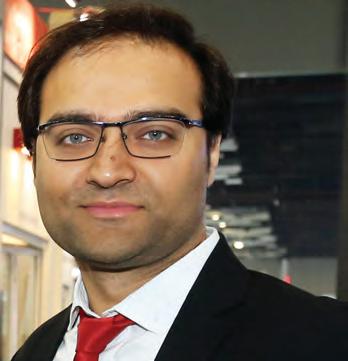
Director - Operations, Kingston Multi Products India (P) Ltd
customised requirements. The company is focused on delivering qualitative products to masses that are solution-oriented for the application hence delivering the promised performance.
With premium product quality and 11 years of effort, Kingston becomes the market leader in the false ceilings and silicone sealant industry. Kingston products meet the European standard and qualities parameters measured and certified by well-established labs of India like SGS, ARAI, and CPWD Institution.
Kingston Multi Products India (P) Ltd.
805, 8th Floor, D Mall, Netaji Subhash Place, Delhi-110034
Tel: +91 9899983249
E-mail: info@kingstoninteriors.in













Insta was launched in 2008. Please tell us about a few of your milestone developments since then?
l Insta brand was launched in 2008 when the founders of the company decided to build their own brand. Management is from the construction field, working as a civil contractor for many government bodies like CPWD and PWD. Insta started with glass architectural hardware.
l In 2011, started aluminium doors & windows hardware.
l In 2015, the company became the distributor for a multinational brand from Germany for uPVC doors and windows.


l In 2019, management decided to launch uPVC door window hardware in its own brand name INSTA.
Kindly brief us on your products and services?
INSTA now is serving the fenestration industry. We provide a



NITIN GUPTA
Director - Operations, Glorious products India Pvt. Ltd. (Insta Hardware)
complete solution of the hardware for aluminium and uPVC doors, windows and façades. The product range includes transmission gears, multipoint locks, friction hinges, rollers, etc. We provide glass architectural hardware like patch fittings, spiders fitting, shower fittings and railing solutions.
Throw some light on the best practices by Insta which help you to ensure customer delight?
Insta is proving the best quality hardware to our customers. Besides the quality, we provide unique design and technical support to our customers. We get feedback from the customers at regular intervals to give the best products, services for further improvisation. Our sales and supply chain team


RAMAN DHIMAN
Director - Sales and Marketing. Glorious products India Pvt. Ltd. (Insta Hardware)
ensure support on all aspects to keep the customers updated and satisfied.


Tell us about your brand's presence in India and the company’s future expansion plans?
We have our presence in pan India. Although our office and centralised warehouse are situated in Delhi, we have our representatives in Hyderabad, Chennai, Kolkata and Mumbai.
Right now we have OEM agreements with our foreign partners worldwide. We have our plan in the pipeline to start manufacturing facilities in India.
For more information on the product, visit www.instahardware.com
Glorious Products (India) Pvt. Ltd.
910, 9th Floor, D Mall, Netaji Subhash Place, Delhi-110034
Tel: +91 11 40743510 / 11
Email: raman@instahardwares.com; info@instahardwares.com






























Facades
Curtain Wall
Structural Glazing Systems
Metal/ Stone/ Expanded
Mesh Cladding
Sunshade devices/Louvers
Doors & Windows
Bespoke
Thermal Break
Slimline
European systems

Miscellaneous
Point Fix/ Spider/ Patch Fitting Glazing works Canopies & Skylights
R ailings & Ballustrades
Automatics
